Review of Crises and Crisis Management: Integration & Research Dev
VerifiedAdded on 2023/04/21
|51
|34271
|453
Literature Review
AI Summary
This literature review integrates research on crises and crisis management from various disciplines, including strategic management, organizational theory, organizational behavior, public relations, and corporate communication. It proposes a framework incorporating two dominant perspectives: an internal perspective focused on the technical and structural aspects of a crisis and an external perspective focused on managing stakeholder relationships. The review identifies opportunities for integration between these perspectives across three stages: precrisis prevention, crisis management, and postcrisis outcomes. It highlights research on organizational preparedness, stakeholder relationships, crisis leadership, stakeholder perceptions, organizational learning, and social evaluations, providing a foundation for future cross-disciplinary research and practical application. The study also addresses the fragmented nature of crisis management research, aiming to foster a more cohesive understanding of the field.
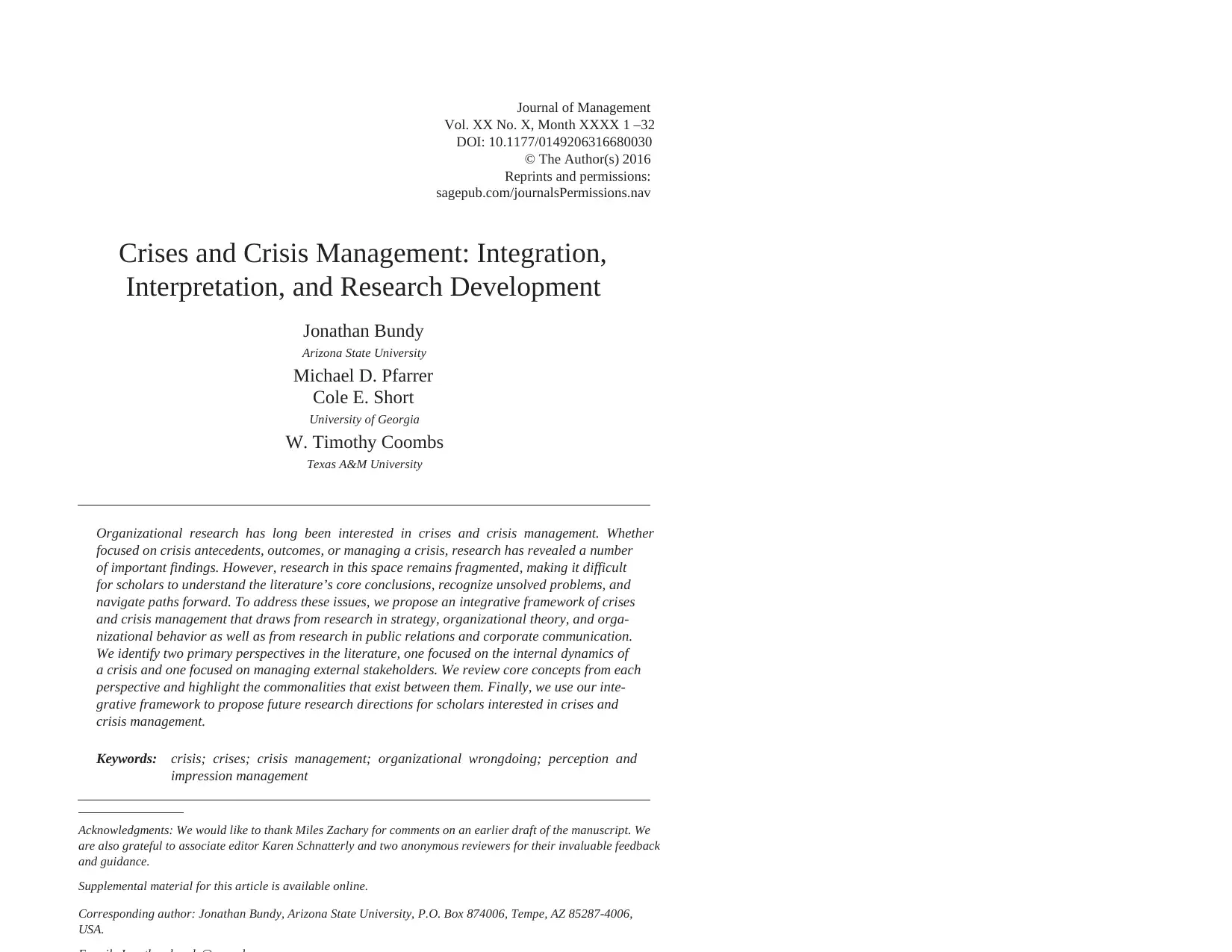
Journal of Management
Vol. XX No. X, Month XXXX 1 –32
DOI: 10.1177/0149206316680030
© The Author(s) 2016
Reprints and permissions:
sagepub.com/journalsPermissions.nav
Crises and Crisis Management: Integration,
Interpretation, and Research Development
Jonathan Bundy
Arizona State University
Michael D. Pfarrer
Cole E. Short
University of Georgia
W. Timothy Coombs
Texas A&M University
Organizational research has long been interested in crises and crisis management. Whether
focused on crisis antecedents, outcomes, or managing a crisis, research has revealed a number
of important findings. However, research in this space remains fragmented, making it difficult
for scholars to understand the literature’s core conclusions, recognize unsolved problems, and
navigate paths forward. To address these issues, we propose an integrative framework of crises
and crisis management that draws from research in strategy, organizational theory, and orga-
nizational behavior as well as from research in public relations and corporate communication.
We identify two primary perspectives in the literature, one focused on the internal dynamics of
a crisis and one focused on managing external stakeholders. We review core concepts from each
perspective and highlight the commonalities that exist between them. Finally, we use our inte-
grative framework to propose future research directions for scholars interested in crises and
crisis management.
Keywords: crisis; crises; crisis management; organizational wrongdoing; perception and
impression management
Acknowledgments: We would like to thank Miles Zachary for comments on an earlier draft of the manuscript. We
are also grateful to associate editor Karen Schnatterly and two anonymous reviewers for their invaluable feedback
and guidance.
Supplemental material for this article is available online.
Corresponding author: Jonathan Bundy, Arizona State University, P.O. Box 874006, Tempe, AZ 85287-4006,
USA.
680030 JOMXXX10.1177/0149206316680030Journal of Management Bundy et al. / Review of Crises and Crisis Management
research-article2016
Vol. XX No. X, Month XXXX 1 –32
DOI: 10.1177/0149206316680030
© The Author(s) 2016
Reprints and permissions:
sagepub.com/journalsPermissions.nav
Crises and Crisis Management: Integration,
Interpretation, and Research Development
Jonathan Bundy
Arizona State University
Michael D. Pfarrer
Cole E. Short
University of Georgia
W. Timothy Coombs
Texas A&M University
Organizational research has long been interested in crises and crisis management. Whether
focused on crisis antecedents, outcomes, or managing a crisis, research has revealed a number
of important findings. However, research in this space remains fragmented, making it difficult
for scholars to understand the literature’s core conclusions, recognize unsolved problems, and
navigate paths forward. To address these issues, we propose an integrative framework of crises
and crisis management that draws from research in strategy, organizational theory, and orga-
nizational behavior as well as from research in public relations and corporate communication.
We identify two primary perspectives in the literature, one focused on the internal dynamics of
a crisis and one focused on managing external stakeholders. We review core concepts from each
perspective and highlight the commonalities that exist between them. Finally, we use our inte-
grative framework to propose future research directions for scholars interested in crises and
crisis management.
Keywords: crisis; crises; crisis management; organizational wrongdoing; perception and
impression management
Acknowledgments: We would like to thank Miles Zachary for comments on an earlier draft of the manuscript. We
are also grateful to associate editor Karen Schnatterly and two anonymous reviewers for their invaluable feedback
and guidance.
Supplemental material for this article is available online.
Corresponding author: Jonathan Bundy, Arizona State University, P.O. Box 874006, Tempe, AZ 85287-4006,
USA.
680030 JOMXXX10.1177/0149206316680030Journal of Management Bundy et al. / Review of Crises and Crisis Management
research-article2016
Paraphrase This Document
Need a fresh take? Get an instant paraphrase of this document with our AI Paraphraser
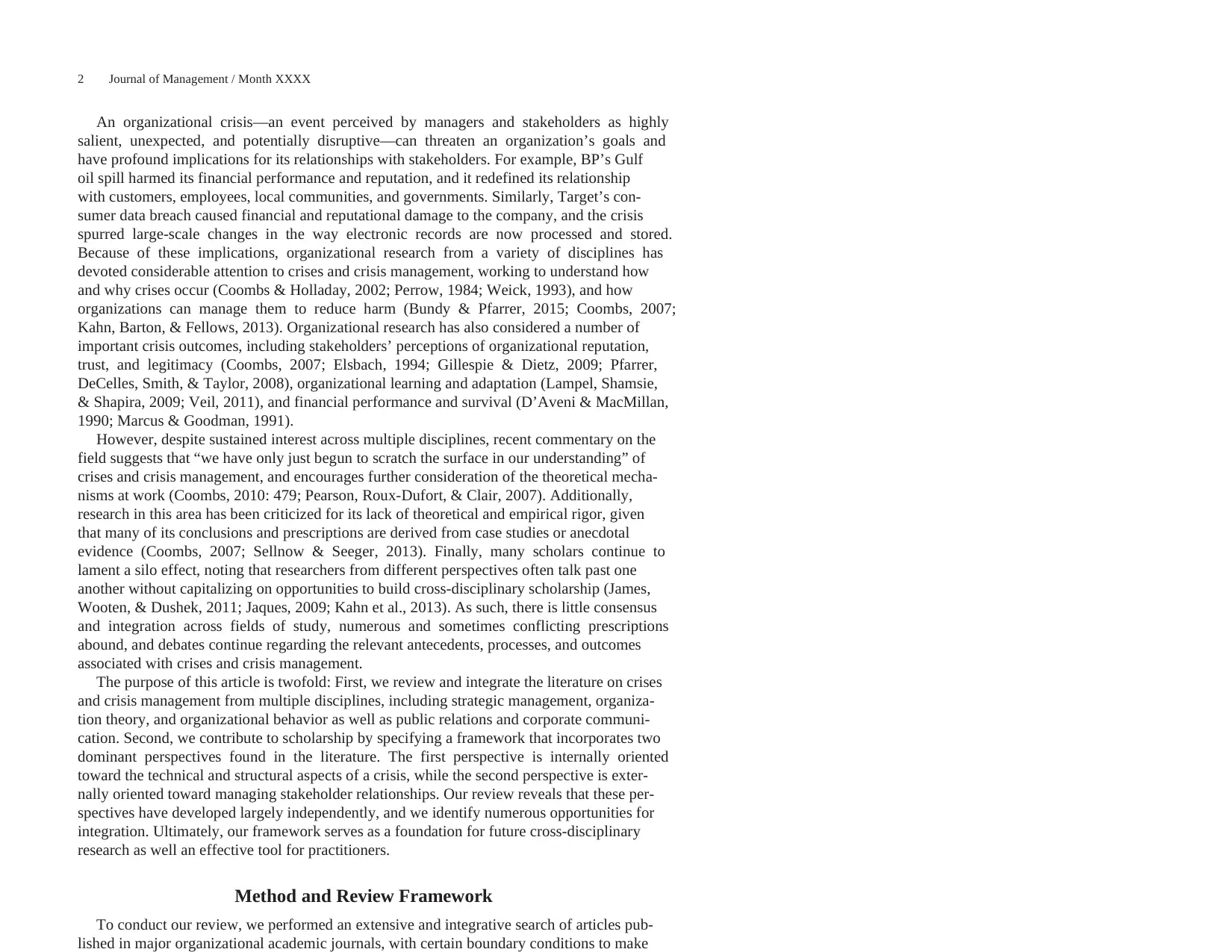
2 Journal of Management / Month XXXX
An organizational crisis—an event perceived by managers and stakeholders as highly
salient, unexpected, and potentially disruptive—can threaten an organization’s goals and
have profound implications for its relationships with stakeholders. For example, BP’s Gulf
oil spill harmed its financial performance and reputation, and it redefined its relationship
with customers, employees, local communities, and governments. Similarly, Target’s con-
sumer data breach caused financial and reputational damage to the company, and the crisis
spurred large-scale changes in the way electronic records are now processed and stored.
Because of these implications, organizational research from a variety of disciplines has
devoted considerable attention to crises and crisis management, working to understand how
and why crises occur (Coombs & Holladay, 2002; Perrow, 1984; Weick, 1993), and how
organizations can manage them to reduce harm (Bundy & Pfarrer, 2015; Coombs, 2007;
Kahn, Barton, & Fellows, 2013). Organizational research has also considered a number of
important crisis outcomes, including stakeholders’ perceptions of organizational reputation,
trust, and legitimacy (Coombs, 2007; Elsbach, 1994; Gillespie & Dietz, 2009; Pfarrer,
DeCelles, Smith, & Taylor, 2008), organizational learning and adaptation (Lampel, Shamsie,
& Shapira, 2009; Veil, 2011), and financial performance and survival (D’Aveni & MacMillan,
1990; Marcus & Goodman, 1991).
However, despite sustained interest across multiple disciplines, recent commentary on the
field suggests that “we have only just begun to scratch the surface in our understanding” of
crises and crisis management, and encourages further consideration of the theoretical mecha-
nisms at work (Coombs, 2010: 479; Pearson, Roux-Dufort, & Clair, 2007). Additionally,
research in this area has been criticized for its lack of theoretical and empirical rigor, given
that many of its conclusions and prescriptions are derived from case studies or anecdotal
evidence (Coombs, 2007; Sellnow & Seeger, 2013). Finally, many scholars continue to
lament a silo effect, noting that researchers from different perspectives often talk past one
another without capitalizing on opportunities to build cross-disciplinary scholarship (James,
Wooten, & Dushek, 2011; Jaques, 2009; Kahn et al., 2013). As such, there is little consensus
and integration across fields of study, numerous and sometimes conflicting prescriptions
abound, and debates continue regarding the relevant antecedents, processes, and outcomes
associated with crises and crisis management.
The purpose of this article is twofold: First, we review and integrate the literature on crises
and crisis management from multiple disciplines, including strategic management, organiza-
tion theory, and organizational behavior as well as public relations and corporate communi-
cation. Second, we contribute to scholarship by specifying a framework that incorporates two
dominant perspectives found in the literature. The first perspective is internally oriented
toward the technical and structural aspects of a crisis, while the second perspective is exter-
nally oriented toward managing stakeholder relationships. Our review reveals that these per-
spectives have developed largely independently, and we identify numerous opportunities for
integration. Ultimately, our framework serves as a foundation for future cross-disciplinary
research as well an effective tool for practitioners.
Method and Review Framework
To conduct our review, we performed an extensive and integrative search of articles pub-
lished in major organizational academic journals, with certain boundary conditions to make
An organizational crisis—an event perceived by managers and stakeholders as highly
salient, unexpected, and potentially disruptive—can threaten an organization’s goals and
have profound implications for its relationships with stakeholders. For example, BP’s Gulf
oil spill harmed its financial performance and reputation, and it redefined its relationship
with customers, employees, local communities, and governments. Similarly, Target’s con-
sumer data breach caused financial and reputational damage to the company, and the crisis
spurred large-scale changes in the way electronic records are now processed and stored.
Because of these implications, organizational research from a variety of disciplines has
devoted considerable attention to crises and crisis management, working to understand how
and why crises occur (Coombs & Holladay, 2002; Perrow, 1984; Weick, 1993), and how
organizations can manage them to reduce harm (Bundy & Pfarrer, 2015; Coombs, 2007;
Kahn, Barton, & Fellows, 2013). Organizational research has also considered a number of
important crisis outcomes, including stakeholders’ perceptions of organizational reputation,
trust, and legitimacy (Coombs, 2007; Elsbach, 1994; Gillespie & Dietz, 2009; Pfarrer,
DeCelles, Smith, & Taylor, 2008), organizational learning and adaptation (Lampel, Shamsie,
& Shapira, 2009; Veil, 2011), and financial performance and survival (D’Aveni & MacMillan,
1990; Marcus & Goodman, 1991).
However, despite sustained interest across multiple disciplines, recent commentary on the
field suggests that “we have only just begun to scratch the surface in our understanding” of
crises and crisis management, and encourages further consideration of the theoretical mecha-
nisms at work (Coombs, 2010: 479; Pearson, Roux-Dufort, & Clair, 2007). Additionally,
research in this area has been criticized for its lack of theoretical and empirical rigor, given
that many of its conclusions and prescriptions are derived from case studies or anecdotal
evidence (Coombs, 2007; Sellnow & Seeger, 2013). Finally, many scholars continue to
lament a silo effect, noting that researchers from different perspectives often talk past one
another without capitalizing on opportunities to build cross-disciplinary scholarship (James,
Wooten, & Dushek, 2011; Jaques, 2009; Kahn et al., 2013). As such, there is little consensus
and integration across fields of study, numerous and sometimes conflicting prescriptions
abound, and debates continue regarding the relevant antecedents, processes, and outcomes
associated with crises and crisis management.
The purpose of this article is twofold: First, we review and integrate the literature on crises
and crisis management from multiple disciplines, including strategic management, organiza-
tion theory, and organizational behavior as well as public relations and corporate communi-
cation. Second, we contribute to scholarship by specifying a framework that incorporates two
dominant perspectives found in the literature. The first perspective is internally oriented
toward the technical and structural aspects of a crisis, while the second perspective is exter-
nally oriented toward managing stakeholder relationships. Our review reveals that these per-
spectives have developed largely independently, and we identify numerous opportunities for
integration. Ultimately, our framework serves as a foundation for future cross-disciplinary
research as well an effective tool for practitioners.
Method and Review Framework
To conduct our review, we performed an extensive and integrative search of articles pub-
lished in major organizational academic journals, with certain boundary conditions to make
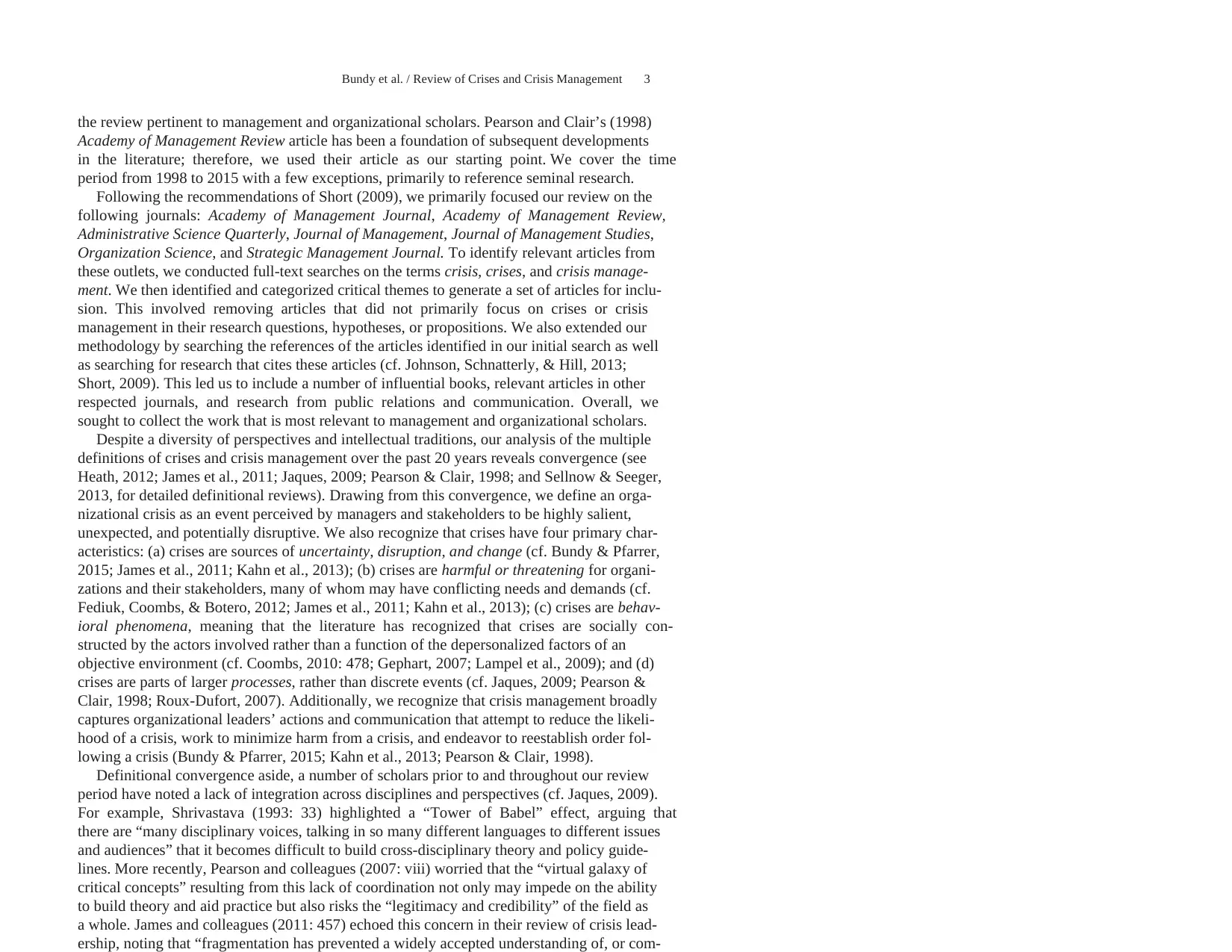
Bundy et al. / Review of Crises and Crisis Management 3
the review pertinent to management and organizational scholars. Pearson and Clair’s (1998)
Academy of Management Review article has been a foundation of subsequent developments
in the literature; therefore, we used their article as our starting point. We cover the time
period from 1998 to 2015 with a few exceptions, primarily to reference seminal research.
Following the recommendations of Short (2009), we primarily focused our review on the
following journals: Academy of Management Journal, Academy of Management Review,
Administrative Science Quarterly, Journal of Management, Journal of Management Studies,
Organization Science, and Strategic Management Journal. To identify relevant articles from
these outlets, we conducted full-text searches on the terms crisis, crises, and crisis manage-
ment. We then identified and categorized critical themes to generate a set of articles for inclu-
sion. This involved removing articles that did not primarily focus on crises or crisis
management in their research questions, hypotheses, or propositions. We also extended our
methodology by searching the references of the articles identified in our initial search as well
as searching for research that cites these articles (cf. Johnson, Schnatterly, & Hill, 2013;
Short, 2009). This led us to include a number of influential books, relevant articles in other
respected journals, and research from public relations and communication. Overall, we
sought to collect the work that is most relevant to management and organizational scholars.
Despite a diversity of perspectives and intellectual traditions, our analysis of the multiple
definitions of crises and crisis management over the past 20 years reveals convergence (see
Heath, 2012; James et al., 2011; Jaques, 2009; Pearson & Clair, 1998; and Sellnow & Seeger,
2013, for detailed definitional reviews). Drawing from this convergence, we define an orga-
nizational crisis as an event perceived by managers and stakeholders to be highly salient,
unexpected, and potentially disruptive. We also recognize that crises have four primary char-
acteristics: (a) crises are sources of uncertainty, disruption, and change (cf. Bundy & Pfarrer,
2015; James et al., 2011; Kahn et al., 2013); (b) crises are harmful or threatening for organi-
zations and their stakeholders, many of whom may have conflicting needs and demands (cf.
Fediuk, Coombs, & Botero, 2012; James et al., 2011; Kahn et al., 2013); (c) crises are behav-
ioral phenomena, meaning that the literature has recognized that crises are socially con-
structed by the actors involved rather than a function of the depersonalized factors of an
objective environment (cf. Coombs, 2010: 478; Gephart, 2007; Lampel et al., 2009); and (d)
crises are parts of larger processes, rather than discrete events (cf. Jaques, 2009; Pearson &
Clair, 1998; Roux-Dufort, 2007). Additionally, we recognize that crisis management broadly
captures organizational leaders’ actions and communication that attempt to reduce the likeli-
hood of a crisis, work to minimize harm from a crisis, and endeavor to reestablish order fol-
lowing a crisis (Bundy & Pfarrer, 2015; Kahn et al., 2013; Pearson & Clair, 1998).
Definitional convergence aside, a number of scholars prior to and throughout our review
period have noted a lack of integration across disciplines and perspectives (cf. Jaques, 2009).
For example, Shrivastava (1993: 33) highlighted a “Tower of Babel” effect, arguing that
there are “many disciplinary voices, talking in so many different languages to different issues
and audiences” that it becomes difficult to build cross-disciplinary theory and policy guide-
lines. More recently, Pearson and colleagues (2007: viii) worried that the “virtual galaxy of
critical concepts” resulting from this lack of coordination not only may impede on the ability
to build theory and aid practice but also risks the “legitimacy and credibility” of the field as
a whole. James and colleagues (2011: 457) echoed this concern in their review of crisis lead-
ership, noting that “fragmentation has prevented a widely accepted understanding of, or com-
the review pertinent to management and organizational scholars. Pearson and Clair’s (1998)
Academy of Management Review article has been a foundation of subsequent developments
in the literature; therefore, we used their article as our starting point. We cover the time
period from 1998 to 2015 with a few exceptions, primarily to reference seminal research.
Following the recommendations of Short (2009), we primarily focused our review on the
following journals: Academy of Management Journal, Academy of Management Review,
Administrative Science Quarterly, Journal of Management, Journal of Management Studies,
Organization Science, and Strategic Management Journal. To identify relevant articles from
these outlets, we conducted full-text searches on the terms crisis, crises, and crisis manage-
ment. We then identified and categorized critical themes to generate a set of articles for inclu-
sion. This involved removing articles that did not primarily focus on crises or crisis
management in their research questions, hypotheses, or propositions. We also extended our
methodology by searching the references of the articles identified in our initial search as well
as searching for research that cites these articles (cf. Johnson, Schnatterly, & Hill, 2013;
Short, 2009). This led us to include a number of influential books, relevant articles in other
respected journals, and research from public relations and communication. Overall, we
sought to collect the work that is most relevant to management and organizational scholars.
Despite a diversity of perspectives and intellectual traditions, our analysis of the multiple
definitions of crises and crisis management over the past 20 years reveals convergence (see
Heath, 2012; James et al., 2011; Jaques, 2009; Pearson & Clair, 1998; and Sellnow & Seeger,
2013, for detailed definitional reviews). Drawing from this convergence, we define an orga-
nizational crisis as an event perceived by managers and stakeholders to be highly salient,
unexpected, and potentially disruptive. We also recognize that crises have four primary char-
acteristics: (a) crises are sources of uncertainty, disruption, and change (cf. Bundy & Pfarrer,
2015; James et al., 2011; Kahn et al., 2013); (b) crises are harmful or threatening for organi-
zations and their stakeholders, many of whom may have conflicting needs and demands (cf.
Fediuk, Coombs, & Botero, 2012; James et al., 2011; Kahn et al., 2013); (c) crises are behav-
ioral phenomena, meaning that the literature has recognized that crises are socially con-
structed by the actors involved rather than a function of the depersonalized factors of an
objective environment (cf. Coombs, 2010: 478; Gephart, 2007; Lampel et al., 2009); and (d)
crises are parts of larger processes, rather than discrete events (cf. Jaques, 2009; Pearson &
Clair, 1998; Roux-Dufort, 2007). Additionally, we recognize that crisis management broadly
captures organizational leaders’ actions and communication that attempt to reduce the likeli-
hood of a crisis, work to minimize harm from a crisis, and endeavor to reestablish order fol-
lowing a crisis (Bundy & Pfarrer, 2015; Kahn et al., 2013; Pearson & Clair, 1998).
Definitional convergence aside, a number of scholars prior to and throughout our review
period have noted a lack of integration across disciplines and perspectives (cf. Jaques, 2009).
For example, Shrivastava (1993: 33) highlighted a “Tower of Babel” effect, arguing that
there are “many disciplinary voices, talking in so many different languages to different issues
and audiences” that it becomes difficult to build cross-disciplinary theory and policy guide-
lines. More recently, Pearson and colleagues (2007: viii) worried that the “virtual galaxy of
critical concepts” resulting from this lack of coordination not only may impede on the ability
to build theory and aid practice but also risks the “legitimacy and credibility” of the field as
a whole. James and colleagues (2011: 457) echoed this concern in their review of crisis lead-
ership, noting that “fragmentation has prevented a widely accepted understanding of, or com-
⊘ This is a preview!⊘
Do you want full access?
Subscribe today to unlock all pages.

Trusted by 1+ million students worldwide
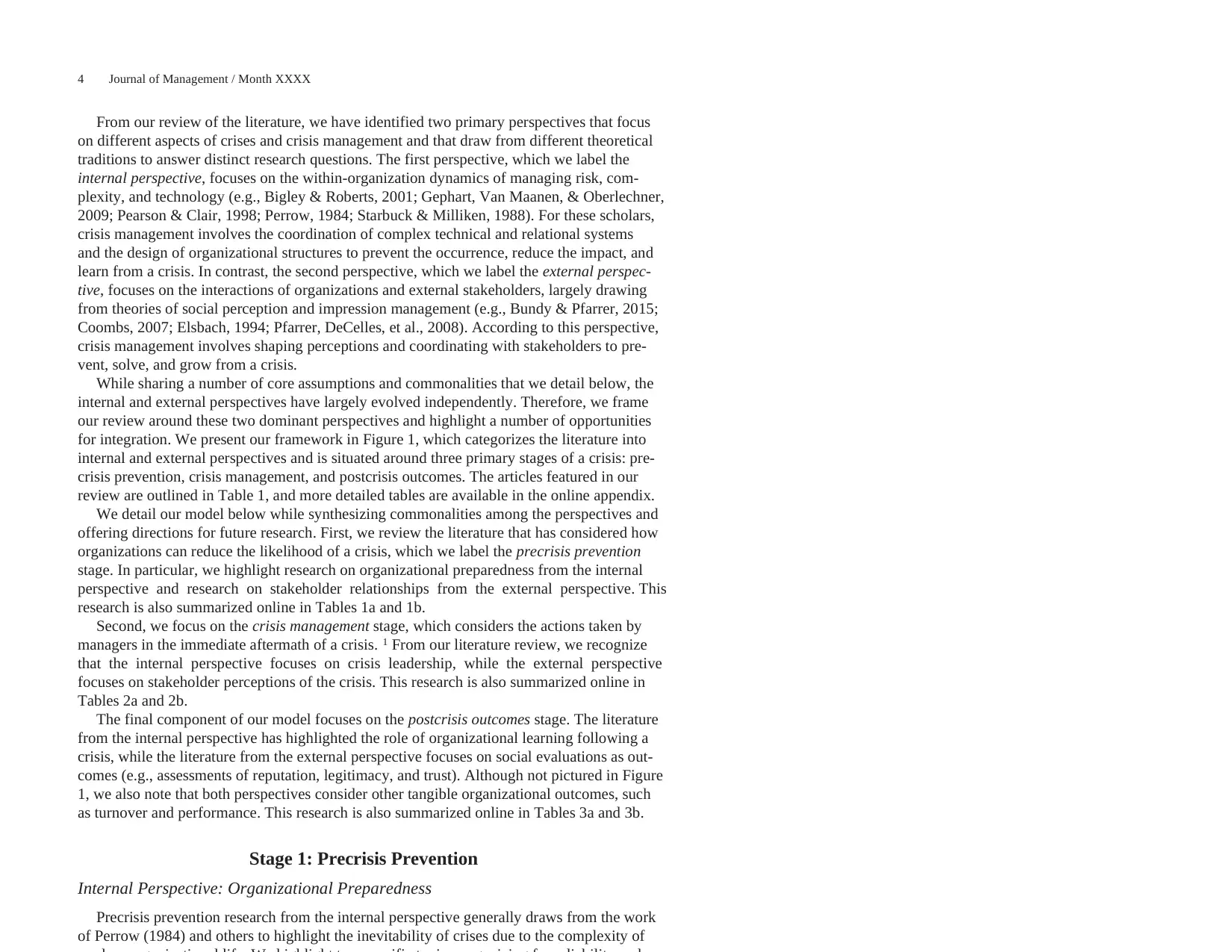
4 Journal of Management / Month XXXX
From our review of the literature, we have identified two primary perspectives that focus
on different aspects of crises and crisis management and that draw from different theoretical
traditions to answer distinct research questions. The first perspective, which we label the
internal perspective, focuses on the within-organization dynamics of managing risk, com-
plexity, and technology (e.g., Bigley & Roberts, 2001; Gephart, Van Maanen, & Oberlechner,
2009; Pearson & Clair, 1998; Perrow, 1984; Starbuck & Milliken, 1988). For these scholars,
crisis management involves the coordination of complex technical and relational systems
and the design of organizational structures to prevent the occurrence, reduce the impact, and
learn from a crisis. In contrast, the second perspective, which we label the external perspec-
tive, focuses on the interactions of organizations and external stakeholders, largely drawing
from theories of social perception and impression management (e.g., Bundy & Pfarrer, 2015;
Coombs, 2007; Elsbach, 1994; Pfarrer, DeCelles, et al., 2008). According to this perspective,
crisis management involves shaping perceptions and coordinating with stakeholders to pre-
vent, solve, and grow from a crisis.
While sharing a number of core assumptions and commonalities that we detail below, the
internal and external perspectives have largely evolved independently. Therefore, we frame
our review around these two dominant perspectives and highlight a number of opportunities
for integration. We present our framework in Figure 1, which categorizes the literature into
internal and external perspectives and is situated around three primary stages of a crisis: pre-
crisis prevention, crisis management, and postcrisis outcomes. The articles featured in our
review are outlined in Table 1, and more detailed tables are available in the online appendix.
We detail our model below while synthesizing commonalities among the perspectives and
offering directions for future research. First, we review the literature that has considered how
organizations can reduce the likelihood of a crisis, which we label the precrisis prevention
stage. In particular, we highlight research on organizational preparedness from the internal
perspective and research on stakeholder relationships from the external perspective. This
research is also summarized online in Tables 1a and 1b.
Second, we focus on the crisis management stage, which considers the actions taken by
managers in the immediate aftermath of a crisis. 1 From our literature review, we recognize
that the internal perspective focuses on crisis leadership, while the external perspective
focuses on stakeholder perceptions of the crisis. This research is also summarized online in
Tables 2a and 2b.
The final component of our model focuses on the postcrisis outcomes stage. The literature
from the internal perspective has highlighted the role of organizational learning following a
crisis, while the literature from the external perspective focuses on social evaluations as out-
comes (e.g., assessments of reputation, legitimacy, and trust). Although not pictured in Figure
1, we also note that both perspectives consider other tangible organizational outcomes, such
as turnover and performance. This research is also summarized online in Tables 3a and 3b.
Stage 1: Precrisis Prevention
Internal Perspective: Organizational Preparedness
Precrisis prevention research from the internal perspective generally draws from the work
of Perrow (1984) and others to highlight the inevitability of crises due to the complexity of
From our review of the literature, we have identified two primary perspectives that focus
on different aspects of crises and crisis management and that draw from different theoretical
traditions to answer distinct research questions. The first perspective, which we label the
internal perspective, focuses on the within-organization dynamics of managing risk, com-
plexity, and technology (e.g., Bigley & Roberts, 2001; Gephart, Van Maanen, & Oberlechner,
2009; Pearson & Clair, 1998; Perrow, 1984; Starbuck & Milliken, 1988). For these scholars,
crisis management involves the coordination of complex technical and relational systems
and the design of organizational structures to prevent the occurrence, reduce the impact, and
learn from a crisis. In contrast, the second perspective, which we label the external perspec-
tive, focuses on the interactions of organizations and external stakeholders, largely drawing
from theories of social perception and impression management (e.g., Bundy & Pfarrer, 2015;
Coombs, 2007; Elsbach, 1994; Pfarrer, DeCelles, et al., 2008). According to this perspective,
crisis management involves shaping perceptions and coordinating with stakeholders to pre-
vent, solve, and grow from a crisis.
While sharing a number of core assumptions and commonalities that we detail below, the
internal and external perspectives have largely evolved independently. Therefore, we frame
our review around these two dominant perspectives and highlight a number of opportunities
for integration. We present our framework in Figure 1, which categorizes the literature into
internal and external perspectives and is situated around three primary stages of a crisis: pre-
crisis prevention, crisis management, and postcrisis outcomes. The articles featured in our
review are outlined in Table 1, and more detailed tables are available in the online appendix.
We detail our model below while synthesizing commonalities among the perspectives and
offering directions for future research. First, we review the literature that has considered how
organizations can reduce the likelihood of a crisis, which we label the precrisis prevention
stage. In particular, we highlight research on organizational preparedness from the internal
perspective and research on stakeholder relationships from the external perspective. This
research is also summarized online in Tables 1a and 1b.
Second, we focus on the crisis management stage, which considers the actions taken by
managers in the immediate aftermath of a crisis. 1 From our literature review, we recognize
that the internal perspective focuses on crisis leadership, while the external perspective
focuses on stakeholder perceptions of the crisis. This research is also summarized online in
Tables 2a and 2b.
The final component of our model focuses on the postcrisis outcomes stage. The literature
from the internal perspective has highlighted the role of organizational learning following a
crisis, while the literature from the external perspective focuses on social evaluations as out-
comes (e.g., assessments of reputation, legitimacy, and trust). Although not pictured in Figure
1, we also note that both perspectives consider other tangible organizational outcomes, such
as turnover and performance. This research is also summarized online in Tables 3a and 3b.
Stage 1: Precrisis Prevention
Internal Perspective: Organizational Preparedness
Precrisis prevention research from the internal perspective generally draws from the work
of Perrow (1984) and others to highlight the inevitability of crises due to the complexity of
Paraphrase This Document
Need a fresh take? Get an instant paraphrase of this document with our AI Paraphraser
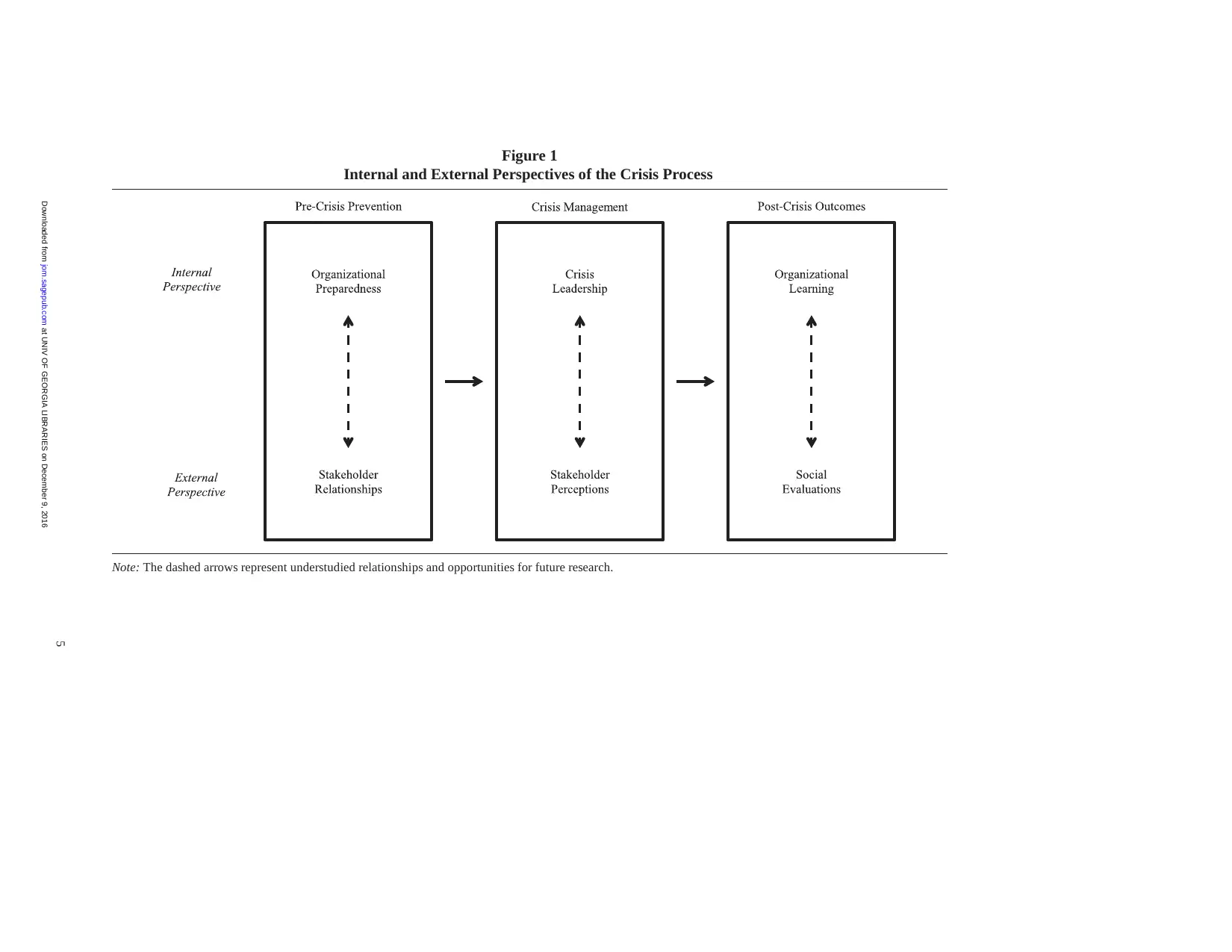
5
Figure 1
Internal and External Perspectives of the Crisis Process
Note: The dashed arrows represent understudied relationships and opportunities for future research.
at UNIV OF GEORGIA LIBRARIES on December 9, 2016jom.sagepub.comDownloaded from
Figure 1
Internal and External Perspectives of the Crisis Process
Note: The dashed arrows represent understudied relationships and opportunities for future research.
at UNIV OF GEORGIA LIBRARIES on December 9, 2016jom.sagepub.comDownloaded from
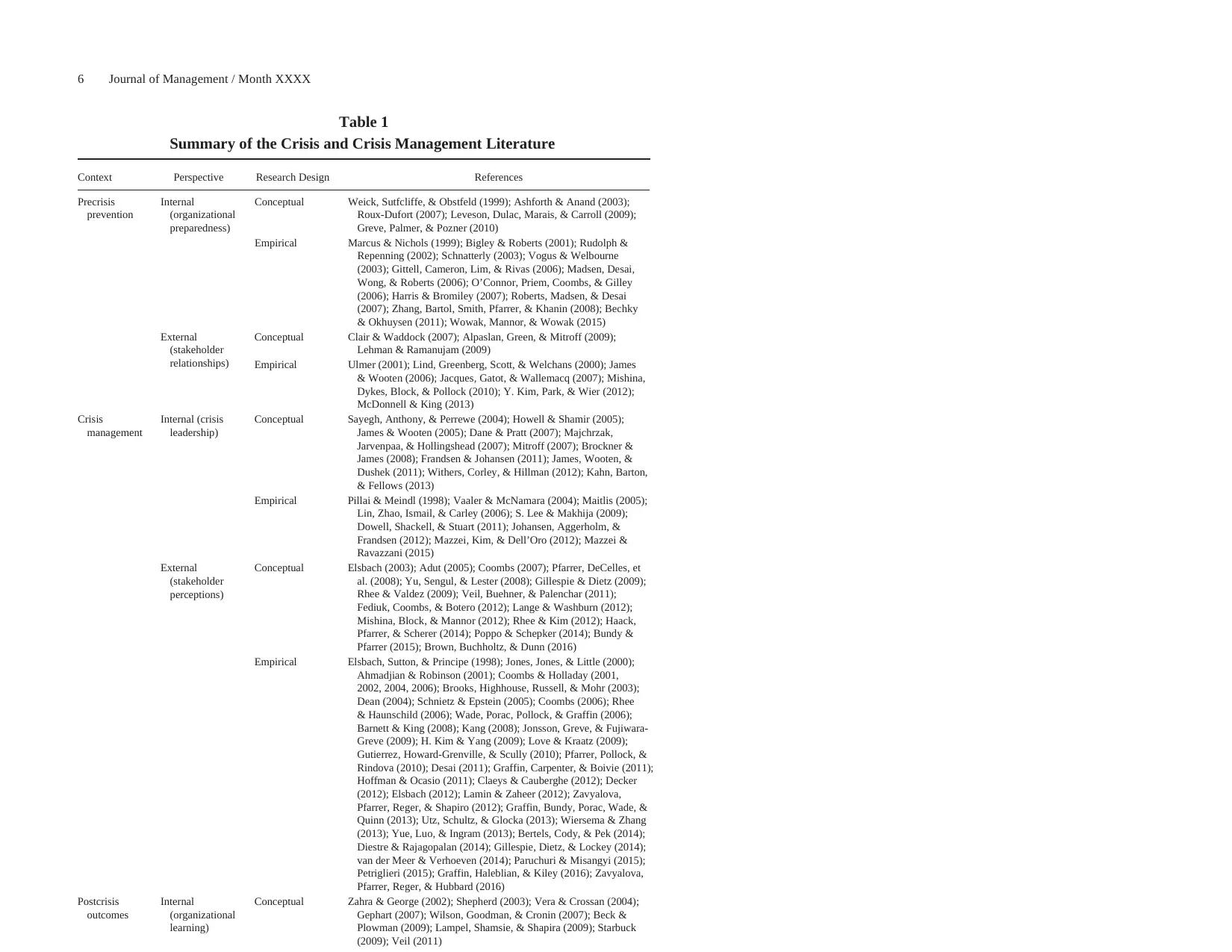
6 Journal of Management / Month XXXX
Table 1
Summary of the Crisis and Crisis Management Literature
Context Perspective Research Design References
Precrisis
prevention
Internal
(organizational
preparedness)
Conceptual Weick, Sutfcliffe, & Obstfeld (1999); Ashforth & Anand (2003);
Roux-Dufort (2007); Leveson, Dulac, Marais, & Carroll (2009);
Greve, Palmer, & Pozner (2010)
Empirical Marcus & Nichols (1999); Bigley & Roberts (2001); Rudolph &
Repenning (2002); Schnatterly (2003); Vogus & Welbourne
(2003); Gittell, Cameron, Lim, & Rivas (2006); Madsen, Desai,
Wong, & Roberts (2006); O’Connor, Priem, Coombs, & Gilley
(2006); Harris & Bromiley (2007); Roberts, Madsen, & Desai
(2007); Zhang, Bartol, Smith, Pfarrer, & Khanin (2008); Bechky
& Okhuysen (2011); Wowak, Mannor, & Wowak (2015)
External
(stakeholder
relationships)
Conceptual Clair & Waddock (2007); Alpaslan, Green, & Mitroff (2009);
Lehman & Ramanujam (2009)
Empirical Ulmer (2001); Lind, Greenberg, Scott, & Welchans (2000); James
& Wooten (2006); Jacques, Gatot, & Wallemacq (2007); Mishina,
Dykes, Block, & Pollock (2010); Y. Kim, Park, & Wier (2012);
McDonnell & King (2013)
Crisis
management
Internal (crisis
leadership)
Conceptual Sayegh, Anthony, & Perrewe (2004); Howell & Shamir (2005);
James & Wooten (2005); Dane & Pratt (2007); Majchrzak,
Jarvenpaa, & Hollingshead (2007); Mitroff (2007); Brockner &
James (2008); Frandsen & Johansen (2011); James, Wooten, &
Dushek (2011); Withers, Corley, & Hillman (2012); Kahn, Barton,
& Fellows (2013)
Empirical Pillai & Meindl (1998); Vaaler & McNamara (2004); Maitlis (2005);
Lin, Zhao, Ismail, & Carley (2006); S. Lee & Makhija (2009);
Dowell, Shackell, & Stuart (2011); Johansen, Aggerholm, &
Frandsen (2012); Mazzei, Kim, & Dell’Oro (2012); Mazzei &
Ravazzani (2015)
External
(stakeholder
perceptions)
Conceptual Elsbach (2003); Adut (2005); Coombs (2007); Pfarrer, DeCelles, et
al. (2008); Yu, Sengul, & Lester (2008); Gillespie & Dietz (2009);
Rhee & Valdez (2009); Veil, Buehner, & Palenchar (2011);
Fediuk, Coombs, & Botero (2012); Lange & Washburn (2012);
Mishina, Block, & Mannor (2012); Rhee & Kim (2012); Haack,
Pfarrer, & Scherer (2014); Poppo & Schepker (2014); Bundy &
Pfarrer (2015); Brown, Buchholtz, & Dunn (2016)
Empirical Elsbach, Sutton, & Principe (1998); Jones, Jones, & Little (2000);
Ahmadjian & Robinson (2001); Coombs & Holladay (2001,
2002, 2004, 2006); Brooks, Highhouse, Russell, & Mohr (2003);
Dean (2004); Schnietz & Epstein (2005); Coombs (2006); Rhee
& Haunschild (2006); Wade, Porac, Pollock, & Graffin (2006);
Barnett & King (2008); Kang (2008); Jonsson, Greve, & Fujiwara-
Greve (2009); H. Kim & Yang (2009); Love & Kraatz (2009);
Gutierrez, Howard-Grenville, & Scully (2010); Pfarrer, Pollock, &
Rindova (2010); Desai (2011); Graffin, Carpenter, & Boivie (2011);
Hoffman & Ocasio (2011); Claeys & Cauberghe (2012); Decker
(2012); Elsbach (2012); Lamin & Zaheer (2012); Zavyalova,
Pfarrer, Reger, & Shapiro (2012); Graffin, Bundy, Porac, Wade, &
Quinn (2013); Utz, Schultz, & Glocka (2013); Wiersema & Zhang
(2013); Yue, Luo, & Ingram (2013); Bertels, Cody, & Pek (2014);
Diestre & Rajagopalan (2014); Gillespie, Dietz, & Lockey (2014);
van der Meer & Verhoeven (2014); Paruchuri & Misangyi (2015);
Petriglieri (2015); Graffin, Haleblian, & Kiley (2016); Zavyalova,
Pfarrer, Reger, & Hubbard (2016)
Postcrisis
outcomes
Internal
(organizational
learning)
Conceptual Zahra & George (2002); Shepherd (2003); Vera & Crossan (2004);
Gephart (2007); Wilson, Goodman, & Cronin (2007); Beck &
Plowman (2009); Lampel, Shamsie, & Shapira (2009); Starbuck
(2009); Veil (2011)
Table 1
Summary of the Crisis and Crisis Management Literature
Context Perspective Research Design References
Precrisis
prevention
Internal
(organizational
preparedness)
Conceptual Weick, Sutfcliffe, & Obstfeld (1999); Ashforth & Anand (2003);
Roux-Dufort (2007); Leveson, Dulac, Marais, & Carroll (2009);
Greve, Palmer, & Pozner (2010)
Empirical Marcus & Nichols (1999); Bigley & Roberts (2001); Rudolph &
Repenning (2002); Schnatterly (2003); Vogus & Welbourne
(2003); Gittell, Cameron, Lim, & Rivas (2006); Madsen, Desai,
Wong, & Roberts (2006); O’Connor, Priem, Coombs, & Gilley
(2006); Harris & Bromiley (2007); Roberts, Madsen, & Desai
(2007); Zhang, Bartol, Smith, Pfarrer, & Khanin (2008); Bechky
& Okhuysen (2011); Wowak, Mannor, & Wowak (2015)
External
(stakeholder
relationships)
Conceptual Clair & Waddock (2007); Alpaslan, Green, & Mitroff (2009);
Lehman & Ramanujam (2009)
Empirical Ulmer (2001); Lind, Greenberg, Scott, & Welchans (2000); James
& Wooten (2006); Jacques, Gatot, & Wallemacq (2007); Mishina,
Dykes, Block, & Pollock (2010); Y. Kim, Park, & Wier (2012);
McDonnell & King (2013)
Crisis
management
Internal (crisis
leadership)
Conceptual Sayegh, Anthony, & Perrewe (2004); Howell & Shamir (2005);
James & Wooten (2005); Dane & Pratt (2007); Majchrzak,
Jarvenpaa, & Hollingshead (2007); Mitroff (2007); Brockner &
James (2008); Frandsen & Johansen (2011); James, Wooten, &
Dushek (2011); Withers, Corley, & Hillman (2012); Kahn, Barton,
& Fellows (2013)
Empirical Pillai & Meindl (1998); Vaaler & McNamara (2004); Maitlis (2005);
Lin, Zhao, Ismail, & Carley (2006); S. Lee & Makhija (2009);
Dowell, Shackell, & Stuart (2011); Johansen, Aggerholm, &
Frandsen (2012); Mazzei, Kim, & Dell’Oro (2012); Mazzei &
Ravazzani (2015)
External
(stakeholder
perceptions)
Conceptual Elsbach (2003); Adut (2005); Coombs (2007); Pfarrer, DeCelles, et
al. (2008); Yu, Sengul, & Lester (2008); Gillespie & Dietz (2009);
Rhee & Valdez (2009); Veil, Buehner, & Palenchar (2011);
Fediuk, Coombs, & Botero (2012); Lange & Washburn (2012);
Mishina, Block, & Mannor (2012); Rhee & Kim (2012); Haack,
Pfarrer, & Scherer (2014); Poppo & Schepker (2014); Bundy &
Pfarrer (2015); Brown, Buchholtz, & Dunn (2016)
Empirical Elsbach, Sutton, & Principe (1998); Jones, Jones, & Little (2000);
Ahmadjian & Robinson (2001); Coombs & Holladay (2001,
2002, 2004, 2006); Brooks, Highhouse, Russell, & Mohr (2003);
Dean (2004); Schnietz & Epstein (2005); Coombs (2006); Rhee
& Haunschild (2006); Wade, Porac, Pollock, & Graffin (2006);
Barnett & King (2008); Kang (2008); Jonsson, Greve, & Fujiwara-
Greve (2009); H. Kim & Yang (2009); Love & Kraatz (2009);
Gutierrez, Howard-Grenville, & Scully (2010); Pfarrer, Pollock, &
Rindova (2010); Desai (2011); Graffin, Carpenter, & Boivie (2011);
Hoffman & Ocasio (2011); Claeys & Cauberghe (2012); Decker
(2012); Elsbach (2012); Lamin & Zaheer (2012); Zavyalova,
Pfarrer, Reger, & Shapiro (2012); Graffin, Bundy, Porac, Wade, &
Quinn (2013); Utz, Schultz, & Glocka (2013); Wiersema & Zhang
(2013); Yue, Luo, & Ingram (2013); Bertels, Cody, & Pek (2014);
Diestre & Rajagopalan (2014); Gillespie, Dietz, & Lockey (2014);
van der Meer & Verhoeven (2014); Paruchuri & Misangyi (2015);
Petriglieri (2015); Graffin, Haleblian, & Kiley (2016); Zavyalova,
Pfarrer, Reger, & Hubbard (2016)
Postcrisis
outcomes
Internal
(organizational
learning)
Conceptual Zahra & George (2002); Shepherd (2003); Vera & Crossan (2004);
Gephart (2007); Wilson, Goodman, & Cronin (2007); Beck &
Plowman (2009); Lampel, Shamsie, & Shapira (2009); Starbuck
(2009); Veil (2011)
⊘ This is a preview!⊘
Do you want full access?
Subscribe today to unlock all pages.

Trusted by 1+ million students worldwide
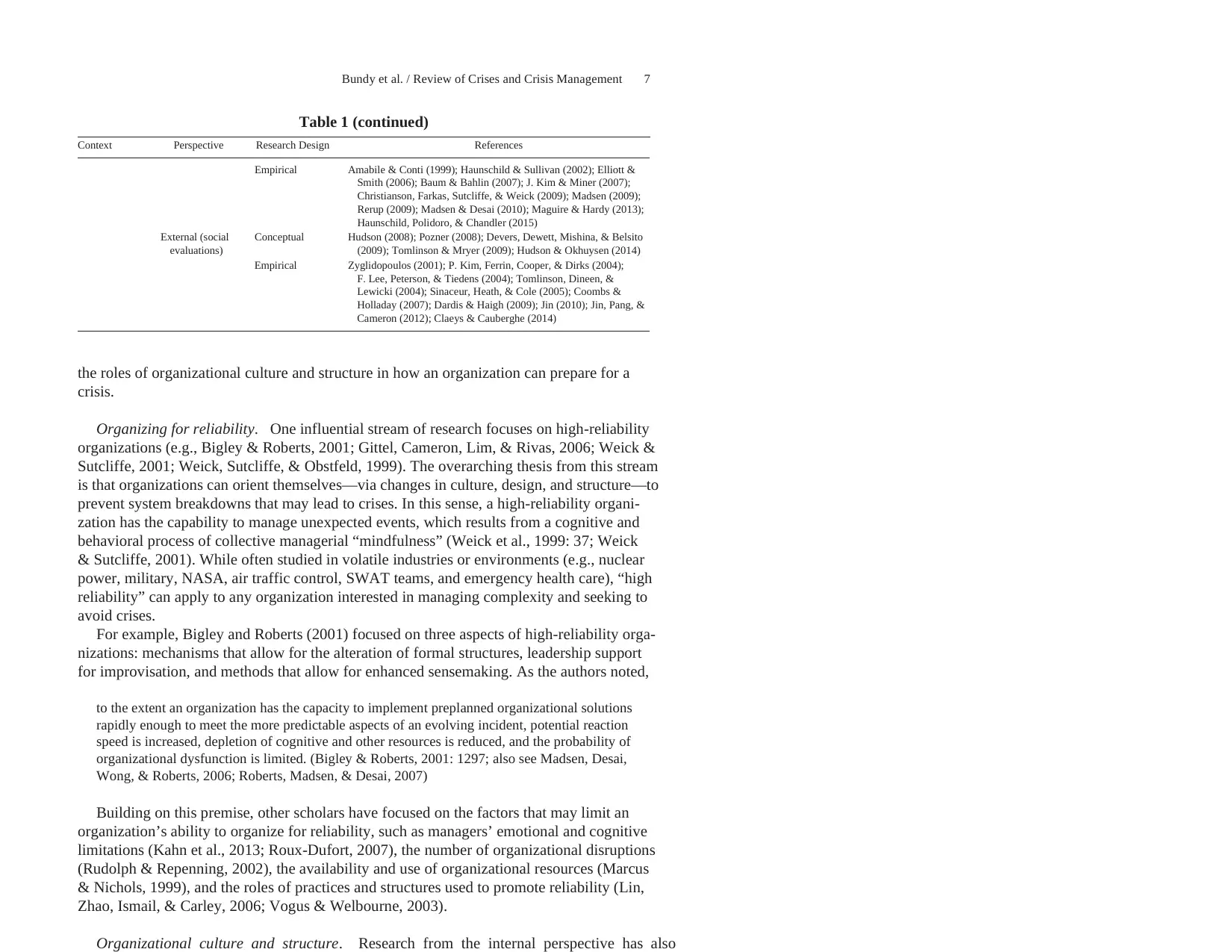
Bundy et al. / Review of Crises and Crisis Management 7
Context Perspective Research Design References
Empirical Amabile & Conti (1999); Haunschild & Sullivan (2002); Elliott &
Smith (2006); Baum & Bahlin (2007); J. Kim & Miner (2007);
Christianson, Farkas, Sutcliffe, & Weick (2009); Madsen (2009);
Rerup (2009); Madsen & Desai (2010); Maguire & Hardy (2013);
Haunschild, Polidoro, & Chandler (2015)
External (social
evaluations)
Conceptual Hudson (2008); Pozner (2008); Devers, Dewett, Mishina, & Belsito
(2009); Tomlinson & Mryer (2009); Hudson & Okhuysen (2014)
Empirical Zyglidopoulos (2001); P. Kim, Ferrin, Cooper, & Dirks (2004);
F. Lee, Peterson, & Tiedens (2004); Tomlinson, Dineen, &
Lewicki (2004); Sinaceur, Heath, & Cole (2005); Coombs &
Holladay (2007); Dardis & Haigh (2009); Jin (2010); Jin, Pang, &
Cameron (2012); Claeys & Cauberghe (2014)
Table 1 (continued)
the roles of organizational culture and structure in how an organization can prepare for a
crisis.
Organizing for reliability. One influential stream of research focuses on high-reliability
organizations (e.g., Bigley & Roberts, 2001; Gittel, Cameron, Lim, & Rivas, 2006; Weick &
Sutcliffe, 2001; Weick, Sutcliffe, & Obstfeld, 1999). The overarching thesis from this stream
is that organizations can orient themselves—via changes in culture, design, and structure—to
prevent system breakdowns that may lead to crises. In this sense, a high-reliability organi-
zation has the capability to manage unexpected events, which results from a cognitive and
behavioral process of collective managerial “mindfulness” (Weick et al., 1999: 37; Weick
& Sutcliffe, 2001). While often studied in volatile industries or environments (e.g., nuclear
power, military, NASA, air traffic control, SWAT teams, and emergency health care), “high
reliability” can apply to any organization interested in managing complexity and seeking to
avoid crises.
For example, Bigley and Roberts (2001) focused on three aspects of high-reliability orga-
nizations: mechanisms that allow for the alteration of formal structures, leadership support
for improvisation, and methods that allow for enhanced sensemaking. As the authors noted,
to the extent an organization has the capacity to implement preplanned organizational solutions
rapidly enough to meet the more predictable aspects of an evolving incident, potential reaction
speed is increased, depletion of cognitive and other resources is reduced, and the probability of
organizational dysfunction is limited. (Bigley & Roberts, 2001: 1297; also see Madsen, Desai,
Wong, & Roberts, 2006; Roberts, Madsen, & Desai, 2007)
Building on this premise, other scholars have focused on the factors that may limit an
organization’s ability to organize for reliability, such as managers’ emotional and cognitive
limitations (Kahn et al., 2013; Roux-Dufort, 2007), the number of organizational disruptions
(Rudolph & Repenning, 2002), the availability and use of organizational resources (Marcus
& Nichols, 1999), and the roles of practices and structures used to promote reliability (Lin,
Zhao, Ismail, & Carley, 2006; Vogus & Welbourne, 2003).
Organizational culture and structure. Research from the internal perspective has also
Context Perspective Research Design References
Empirical Amabile & Conti (1999); Haunschild & Sullivan (2002); Elliott &
Smith (2006); Baum & Bahlin (2007); J. Kim & Miner (2007);
Christianson, Farkas, Sutcliffe, & Weick (2009); Madsen (2009);
Rerup (2009); Madsen & Desai (2010); Maguire & Hardy (2013);
Haunschild, Polidoro, & Chandler (2015)
External (social
evaluations)
Conceptual Hudson (2008); Pozner (2008); Devers, Dewett, Mishina, & Belsito
(2009); Tomlinson & Mryer (2009); Hudson & Okhuysen (2014)
Empirical Zyglidopoulos (2001); P. Kim, Ferrin, Cooper, & Dirks (2004);
F. Lee, Peterson, & Tiedens (2004); Tomlinson, Dineen, &
Lewicki (2004); Sinaceur, Heath, & Cole (2005); Coombs &
Holladay (2007); Dardis & Haigh (2009); Jin (2010); Jin, Pang, &
Cameron (2012); Claeys & Cauberghe (2014)
Table 1 (continued)
the roles of organizational culture and structure in how an organization can prepare for a
crisis.
Organizing for reliability. One influential stream of research focuses on high-reliability
organizations (e.g., Bigley & Roberts, 2001; Gittel, Cameron, Lim, & Rivas, 2006; Weick &
Sutcliffe, 2001; Weick, Sutcliffe, & Obstfeld, 1999). The overarching thesis from this stream
is that organizations can orient themselves—via changes in culture, design, and structure—to
prevent system breakdowns that may lead to crises. In this sense, a high-reliability organi-
zation has the capability to manage unexpected events, which results from a cognitive and
behavioral process of collective managerial “mindfulness” (Weick et al., 1999: 37; Weick
& Sutcliffe, 2001). While often studied in volatile industries or environments (e.g., nuclear
power, military, NASA, air traffic control, SWAT teams, and emergency health care), “high
reliability” can apply to any organization interested in managing complexity and seeking to
avoid crises.
For example, Bigley and Roberts (2001) focused on three aspects of high-reliability orga-
nizations: mechanisms that allow for the alteration of formal structures, leadership support
for improvisation, and methods that allow for enhanced sensemaking. As the authors noted,
to the extent an organization has the capacity to implement preplanned organizational solutions
rapidly enough to meet the more predictable aspects of an evolving incident, potential reaction
speed is increased, depletion of cognitive and other resources is reduced, and the probability of
organizational dysfunction is limited. (Bigley & Roberts, 2001: 1297; also see Madsen, Desai,
Wong, & Roberts, 2006; Roberts, Madsen, & Desai, 2007)
Building on this premise, other scholars have focused on the factors that may limit an
organization’s ability to organize for reliability, such as managers’ emotional and cognitive
limitations (Kahn et al., 2013; Roux-Dufort, 2007), the number of organizational disruptions
(Rudolph & Repenning, 2002), the availability and use of organizational resources (Marcus
& Nichols, 1999), and the roles of practices and structures used to promote reliability (Lin,
Zhao, Ismail, & Carley, 2006; Vogus & Welbourne, 2003).
Organizational culture and structure. Research from the internal perspective has also
Paraphrase This Document
Need a fresh take? Get an instant paraphrase of this document with our AI Paraphraser
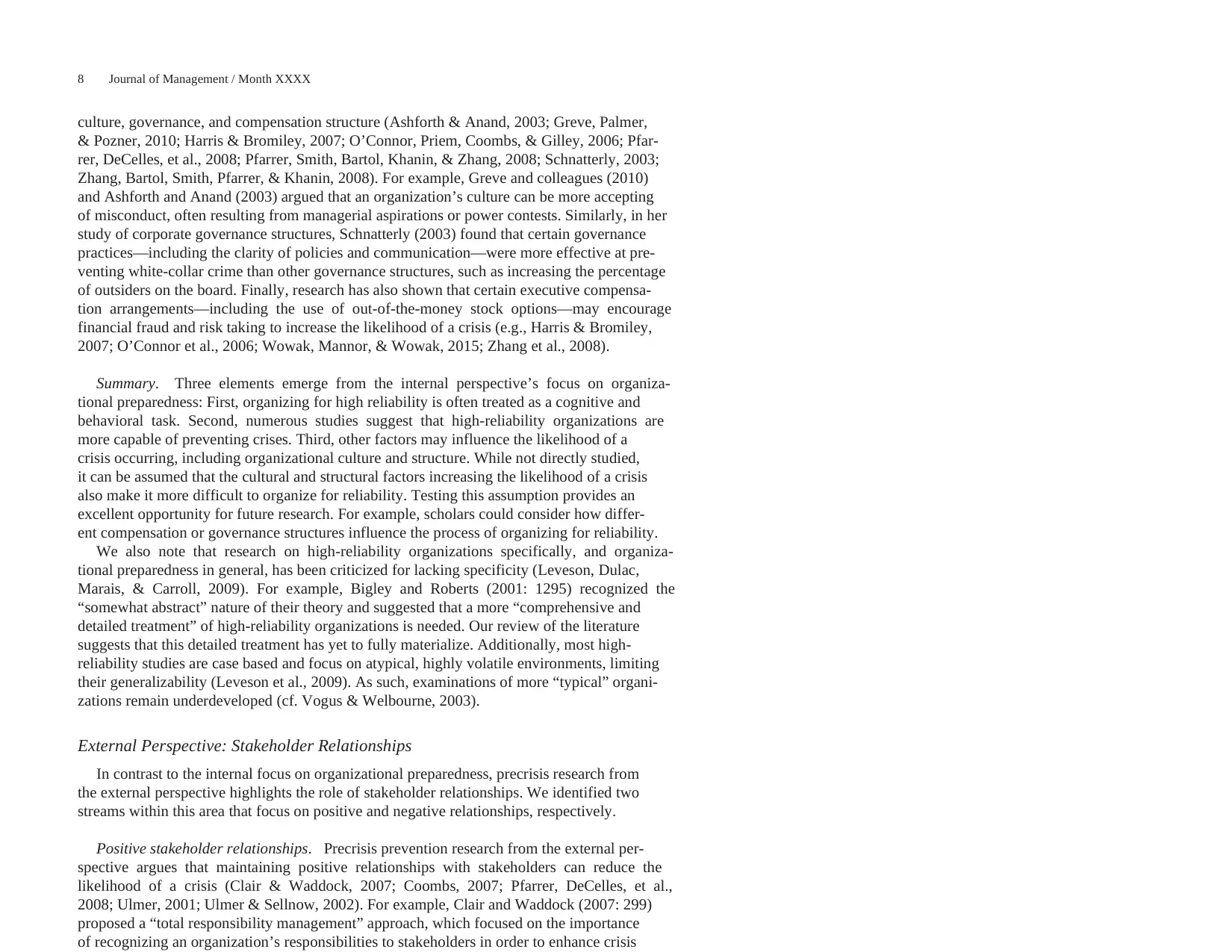
8 Journal of Management / Month XXXX
culture, governance, and compensation structure (Ashforth & Anand, 2003; Greve, Palmer,
& Pozner, 2010; Harris & Bromiley, 2007; O’Connor, Priem, Coombs, & Gilley, 2006; Pfar-
rer, DeCelles, et al., 2008; Pfarrer, Smith, Bartol, Khanin, & Zhang, 2008; Schnatterly, 2003;
Zhang, Bartol, Smith, Pfarrer, & Khanin, 2008). For example, Greve and colleagues (2010)
and Ashforth and Anand (2003) argued that an organization’s culture can be more accepting
of misconduct, often resulting from managerial aspirations or power contests. Similarly, in her
study of corporate governance structures, Schnatterly (2003) found that certain governance
practices—including the clarity of policies and communication—were more effective at pre-
venting white-collar crime than other governance structures, such as increasing the percentage
of outsiders on the board. Finally, research has also shown that certain executive compensa-
tion arrangements—including the use of out-of-the-money stock options—may encourage
financial fraud and risk taking to increase the likelihood of a crisis (e.g., Harris & Bromiley,
2007; O’Connor et al., 2006; Wowak, Mannor, & Wowak, 2015; Zhang et al., 2008).
Summary. Three elements emerge from the internal perspective’s focus on organiza-
tional preparedness: First, organizing for high reliability is often treated as a cognitive and
behavioral task. Second, numerous studies suggest that high-reliability organizations are
more capable of preventing crises. Third, other factors may influence the likelihood of a
crisis occurring, including organizational culture and structure. While not directly studied,
it can be assumed that the cultural and structural factors increasing the likelihood of a crisis
also make it more difficult to organize for reliability. Testing this assumption provides an
excellent opportunity for future research. For example, scholars could consider how differ-
ent compensation or governance structures influence the process of organizing for reliability.
We also note that research on high-reliability organizations specifically, and organiza-
tional preparedness in general, has been criticized for lacking specificity (Leveson, Dulac,
Marais, & Carroll, 2009). For example, Bigley and Roberts (2001: 1295) recognized the
“somewhat abstract” nature of their theory and suggested that a more “comprehensive and
detailed treatment” of high-reliability organizations is needed. Our review of the literature
suggests that this detailed treatment has yet to fully materialize. Additionally, most high-
reliability studies are case based and focus on atypical, highly volatile environments, limiting
their generalizability (Leveson et al., 2009). As such, examinations of more “typical” organi-
zations remain underdeveloped (cf. Vogus & Welbourne, 2003).
External Perspective: Stakeholder Relationships
In contrast to the internal focus on organizational preparedness, precrisis research from
the external perspective highlights the role of stakeholder relationships. We identified two
streams within this area that focus on positive and negative relationships, respectively.
Positive stakeholder relationships. Precrisis prevention research from the external per-
spective argues that maintaining positive relationships with stakeholders can reduce the
likelihood of a crisis (Clair & Waddock, 2007; Coombs, 2007; Pfarrer, DeCelles, et al.,
2008; Ulmer, 2001; Ulmer & Sellnow, 2002). For example, Clair and Waddock (2007: 299)
proposed a “total responsibility management” approach, which focused on the importance
of recognizing an organization’s responsibilities to stakeholders in order to enhance crisis
culture, governance, and compensation structure (Ashforth & Anand, 2003; Greve, Palmer,
& Pozner, 2010; Harris & Bromiley, 2007; O’Connor, Priem, Coombs, & Gilley, 2006; Pfar-
rer, DeCelles, et al., 2008; Pfarrer, Smith, Bartol, Khanin, & Zhang, 2008; Schnatterly, 2003;
Zhang, Bartol, Smith, Pfarrer, & Khanin, 2008). For example, Greve and colleagues (2010)
and Ashforth and Anand (2003) argued that an organization’s culture can be more accepting
of misconduct, often resulting from managerial aspirations or power contests. Similarly, in her
study of corporate governance structures, Schnatterly (2003) found that certain governance
practices—including the clarity of policies and communication—were more effective at pre-
venting white-collar crime than other governance structures, such as increasing the percentage
of outsiders on the board. Finally, research has also shown that certain executive compensa-
tion arrangements—including the use of out-of-the-money stock options—may encourage
financial fraud and risk taking to increase the likelihood of a crisis (e.g., Harris & Bromiley,
2007; O’Connor et al., 2006; Wowak, Mannor, & Wowak, 2015; Zhang et al., 2008).
Summary. Three elements emerge from the internal perspective’s focus on organiza-
tional preparedness: First, organizing for high reliability is often treated as a cognitive and
behavioral task. Second, numerous studies suggest that high-reliability organizations are
more capable of preventing crises. Third, other factors may influence the likelihood of a
crisis occurring, including organizational culture and structure. While not directly studied,
it can be assumed that the cultural and structural factors increasing the likelihood of a crisis
also make it more difficult to organize for reliability. Testing this assumption provides an
excellent opportunity for future research. For example, scholars could consider how differ-
ent compensation or governance structures influence the process of organizing for reliability.
We also note that research on high-reliability organizations specifically, and organiza-
tional preparedness in general, has been criticized for lacking specificity (Leveson, Dulac,
Marais, & Carroll, 2009). For example, Bigley and Roberts (2001: 1295) recognized the
“somewhat abstract” nature of their theory and suggested that a more “comprehensive and
detailed treatment” of high-reliability organizations is needed. Our review of the literature
suggests that this detailed treatment has yet to fully materialize. Additionally, most high-
reliability studies are case based and focus on atypical, highly volatile environments, limiting
their generalizability (Leveson et al., 2009). As such, examinations of more “typical” organi-
zations remain underdeveloped (cf. Vogus & Welbourne, 2003).
External Perspective: Stakeholder Relationships
In contrast to the internal focus on organizational preparedness, precrisis research from
the external perspective highlights the role of stakeholder relationships. We identified two
streams within this area that focus on positive and negative relationships, respectively.
Positive stakeholder relationships. Precrisis prevention research from the external per-
spective argues that maintaining positive relationships with stakeholders can reduce the
likelihood of a crisis (Clair & Waddock, 2007; Coombs, 2007; Pfarrer, DeCelles, et al.,
2008; Ulmer, 2001; Ulmer & Sellnow, 2002). For example, Clair and Waddock (2007: 299)
proposed a “total responsibility management” approach, which focused on the importance
of recognizing an organization’s responsibilities to stakeholders in order to enhance crisis
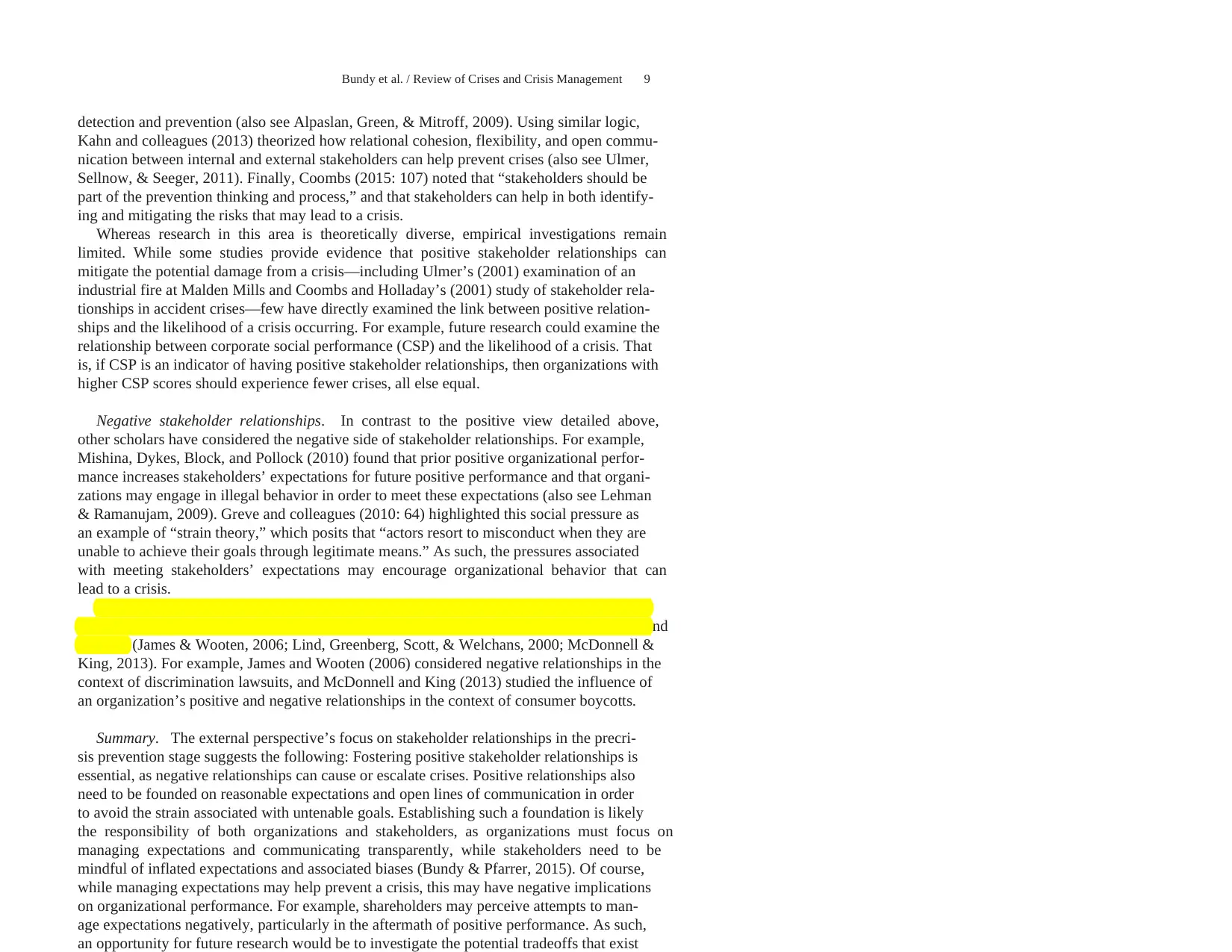
Bundy et al. / Review of Crises and Crisis Management 9
detection and prevention (also see Alpaslan, Green, & Mitroff, 2009). Using similar logic,
Kahn and colleagues (2013) theorized how relational cohesion, flexibility, and open commu-
nication between internal and external stakeholders can help prevent crises (also see Ulmer,
Sellnow, & Seeger, 2011). Finally, Coombs (2015: 107) noted that “stakeholders should be
part of the prevention thinking and process,” and that stakeholders can help in both identify-
ing and mitigating the risks that may lead to a crisis.
Whereas research in this area is theoretically diverse, empirical investigations remain
limited. While some studies provide evidence that positive stakeholder relationships can
mitigate the potential damage from a crisis—including Ulmer’s (2001) examination of an
industrial fire at Malden Mills and Coombs and Holladay’s (2001) study of stakeholder rela-
tionships in accident crises—few have directly examined the link between positive relation-
ships and the likelihood of a crisis occurring. For example, future research could examine the
relationship between corporate social performance (CSP) and the likelihood of a crisis. That
is, if CSP is an indicator of having positive stakeholder relationships, then organizations with
higher CSP scores should experience fewer crises, all else equal.
Negative stakeholder relationships. In contrast to the positive view detailed above,
other scholars have considered the negative side of stakeholder relationships. For example,
Mishina, Dykes, Block, and Pollock (2010) found that prior positive organizational perfor-
mance increases stakeholders’ expectations for future positive performance and that organi-
zations may engage in illegal behavior in order to meet these expectations (also see Lehman
& Ramanujam, 2009). Greve and colleagues (2010: 64) highlighted this social pressure as
an example of “strain theory,” which posits that “actors resort to misconduct when they are
unable to achieve their goals through legitimate means.” As such, the pressures associated
with meeting stakeholders’ expectations may encourage organizational behavior that can
lead to a crisis.
Additionally, scholars have also considered how negative relationships with stakeholders
may trigger a crisis in the form of retaliatory action, including protests, activism, boycotts, and
lawsuits (James & Wooten, 2006; Lind, Greenberg, Scott, & Welchans, 2000; McDonnell &
King, 2013). For example, James and Wooten (2006) considered negative relationships in the
context of discrimination lawsuits, and McDonnell and King (2013) studied the influence of
an organization’s positive and negative relationships in the context of consumer boycotts.
Summary. The external perspective’s focus on stakeholder relationships in the precri-
sis prevention stage suggests the following: Fostering positive stakeholder relationships is
essential, as negative relationships can cause or escalate crises. Positive relationships also
need to be founded on reasonable expectations and open lines of communication in order
to avoid the strain associated with untenable goals. Establishing such a foundation is likely
the responsibility of both organizations and stakeholders, as organizations must focus on
managing expectations and communicating transparently, while stakeholders need to be
mindful of inflated expectations and associated biases (Bundy & Pfarrer, 2015). Of course,
while managing expectations may help prevent a crisis, this may have negative implications
on organizational performance. For example, shareholders may perceive attempts to man-
age expectations negatively, particularly in the aftermath of positive performance. As such,
an opportunity for future research would be to investigate the potential tradeoffs that exist
detection and prevention (also see Alpaslan, Green, & Mitroff, 2009). Using similar logic,
Kahn and colleagues (2013) theorized how relational cohesion, flexibility, and open commu-
nication between internal and external stakeholders can help prevent crises (also see Ulmer,
Sellnow, & Seeger, 2011). Finally, Coombs (2015: 107) noted that “stakeholders should be
part of the prevention thinking and process,” and that stakeholders can help in both identify-
ing and mitigating the risks that may lead to a crisis.
Whereas research in this area is theoretically diverse, empirical investigations remain
limited. While some studies provide evidence that positive stakeholder relationships can
mitigate the potential damage from a crisis—including Ulmer’s (2001) examination of an
industrial fire at Malden Mills and Coombs and Holladay’s (2001) study of stakeholder rela-
tionships in accident crises—few have directly examined the link between positive relation-
ships and the likelihood of a crisis occurring. For example, future research could examine the
relationship between corporate social performance (CSP) and the likelihood of a crisis. That
is, if CSP is an indicator of having positive stakeholder relationships, then organizations with
higher CSP scores should experience fewer crises, all else equal.
Negative stakeholder relationships. In contrast to the positive view detailed above,
other scholars have considered the negative side of stakeholder relationships. For example,
Mishina, Dykes, Block, and Pollock (2010) found that prior positive organizational perfor-
mance increases stakeholders’ expectations for future positive performance and that organi-
zations may engage in illegal behavior in order to meet these expectations (also see Lehman
& Ramanujam, 2009). Greve and colleagues (2010: 64) highlighted this social pressure as
an example of “strain theory,” which posits that “actors resort to misconduct when they are
unable to achieve their goals through legitimate means.” As such, the pressures associated
with meeting stakeholders’ expectations may encourage organizational behavior that can
lead to a crisis.
Additionally, scholars have also considered how negative relationships with stakeholders
may trigger a crisis in the form of retaliatory action, including protests, activism, boycotts, and
lawsuits (James & Wooten, 2006; Lind, Greenberg, Scott, & Welchans, 2000; McDonnell &
King, 2013). For example, James and Wooten (2006) considered negative relationships in the
context of discrimination lawsuits, and McDonnell and King (2013) studied the influence of
an organization’s positive and negative relationships in the context of consumer boycotts.
Summary. The external perspective’s focus on stakeholder relationships in the precri-
sis prevention stage suggests the following: Fostering positive stakeholder relationships is
essential, as negative relationships can cause or escalate crises. Positive relationships also
need to be founded on reasonable expectations and open lines of communication in order
to avoid the strain associated with untenable goals. Establishing such a foundation is likely
the responsibility of both organizations and stakeholders, as organizations must focus on
managing expectations and communicating transparently, while stakeholders need to be
mindful of inflated expectations and associated biases (Bundy & Pfarrer, 2015). Of course,
while managing expectations may help prevent a crisis, this may have negative implications
on organizational performance. For example, shareholders may perceive attempts to man-
age expectations negatively, particularly in the aftermath of positive performance. As such,
an opportunity for future research would be to investigate the potential tradeoffs that exist
⊘ This is a preview!⊘
Do you want full access?
Subscribe today to unlock all pages.

Trusted by 1+ million students worldwide
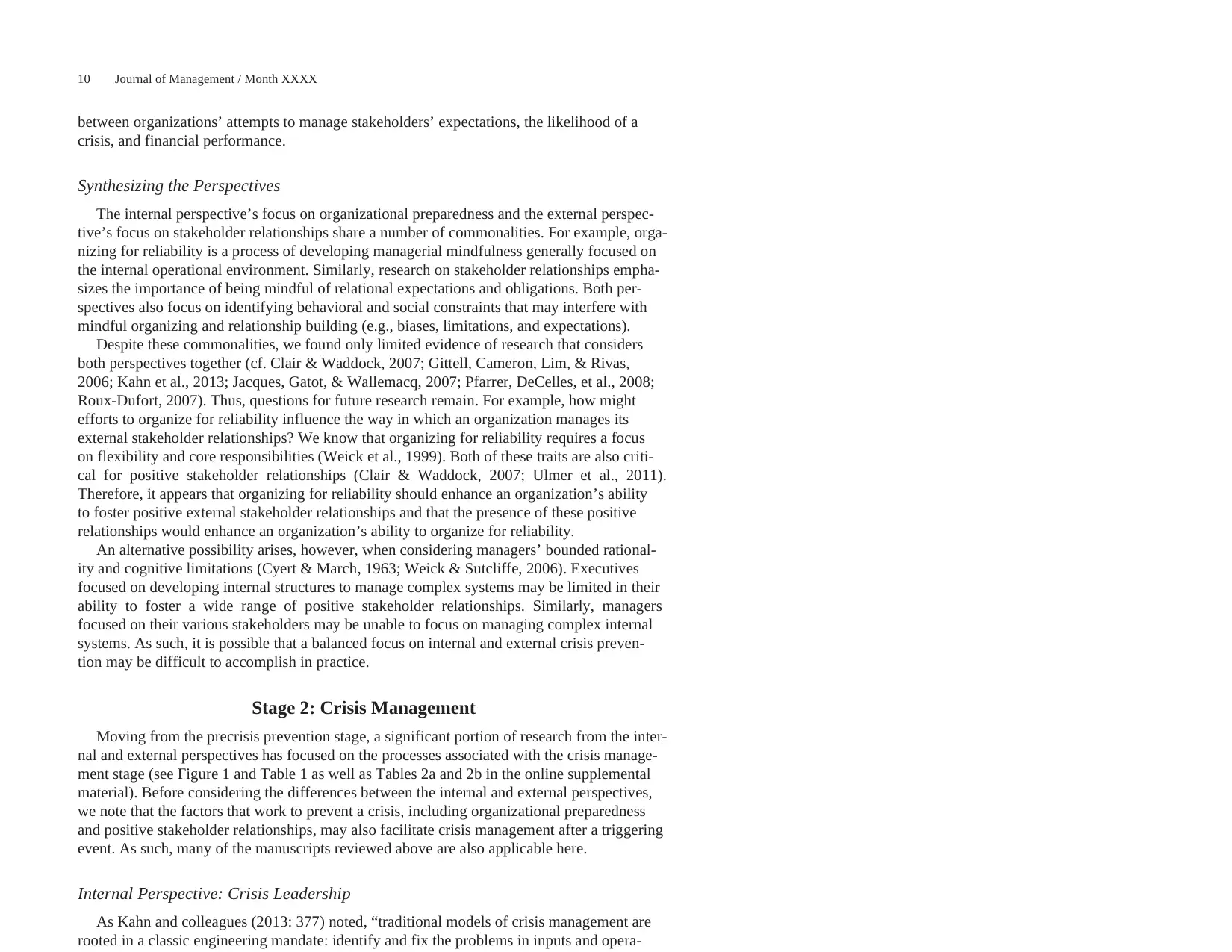
10 Journal of Management / Month XXXX
between organizations’ attempts to manage stakeholders’ expectations, the likelihood of a
crisis, and financial performance.
Synthesizing the Perspectives
The internal perspective’s focus on organizational preparedness and the external perspec-
tive’s focus on stakeholder relationships share a number of commonalities. For example, orga-
nizing for reliability is a process of developing managerial mindfulness generally focused on
the internal operational environment. Similarly, research on stakeholder relationships empha-
sizes the importance of being mindful of relational expectations and obligations. Both per-
spectives also focus on identifying behavioral and social constraints that may interfere with
mindful organizing and relationship building (e.g., biases, limitations, and expectations).
Despite these commonalities, we found only limited evidence of research that considers
both perspectives together (cf. Clair & Waddock, 2007; Gittell, Cameron, Lim, & Rivas,
2006; Kahn et al., 2013; Jacques, Gatot, & Wallemacq, 2007; Pfarrer, DeCelles, et al., 2008;
Roux-Dufort, 2007). Thus, questions for future research remain. For example, how might
efforts to organize for reliability influence the way in which an organization manages its
external stakeholder relationships? We know that organizing for reliability requires a focus
on flexibility and core responsibilities (Weick et al., 1999). Both of these traits are also criti-
cal for positive stakeholder relationships (Clair & Waddock, 2007; Ulmer et al., 2011).
Therefore, it appears that organizing for reliability should enhance an organization’s ability
to foster positive external stakeholder relationships and that the presence of these positive
relationships would enhance an organization’s ability to organize for reliability.
An alternative possibility arises, however, when considering managers’ bounded rational-
ity and cognitive limitations (Cyert & March, 1963; Weick & Sutcliffe, 2006). Executives
focused on developing internal structures to manage complex systems may be limited in their
ability to foster a wide range of positive stakeholder relationships. Similarly, managers
focused on their various stakeholders may be unable to focus on managing complex internal
systems. As such, it is possible that a balanced focus on internal and external crisis preven-
tion may be difficult to accomplish in practice.
Stage 2: Crisis Management
Moving from the precrisis prevention stage, a significant portion of research from the inter-
nal and external perspectives has focused on the processes associated with the crisis manage-
ment stage (see Figure 1 and Table 1 as well as Tables 2a and 2b in the online supplemental
material). Before considering the differences between the internal and external perspectives,
we note that the factors that work to prevent a crisis, including organizational preparedness
and positive stakeholder relationships, may also facilitate crisis management after a triggering
event. As such, many of the manuscripts reviewed above are also applicable here.
Internal Perspective: Crisis Leadership
As Kahn and colleagues (2013: 377) noted, “traditional models of crisis management are
rooted in a classic engineering mandate: identify and fix the problems in inputs and opera-
between organizations’ attempts to manage stakeholders’ expectations, the likelihood of a
crisis, and financial performance.
Synthesizing the Perspectives
The internal perspective’s focus on organizational preparedness and the external perspec-
tive’s focus on stakeholder relationships share a number of commonalities. For example, orga-
nizing for reliability is a process of developing managerial mindfulness generally focused on
the internal operational environment. Similarly, research on stakeholder relationships empha-
sizes the importance of being mindful of relational expectations and obligations. Both per-
spectives also focus on identifying behavioral and social constraints that may interfere with
mindful organizing and relationship building (e.g., biases, limitations, and expectations).
Despite these commonalities, we found only limited evidence of research that considers
both perspectives together (cf. Clair & Waddock, 2007; Gittell, Cameron, Lim, & Rivas,
2006; Kahn et al., 2013; Jacques, Gatot, & Wallemacq, 2007; Pfarrer, DeCelles, et al., 2008;
Roux-Dufort, 2007). Thus, questions for future research remain. For example, how might
efforts to organize for reliability influence the way in which an organization manages its
external stakeholder relationships? We know that organizing for reliability requires a focus
on flexibility and core responsibilities (Weick et al., 1999). Both of these traits are also criti-
cal for positive stakeholder relationships (Clair & Waddock, 2007; Ulmer et al., 2011).
Therefore, it appears that organizing for reliability should enhance an organization’s ability
to foster positive external stakeholder relationships and that the presence of these positive
relationships would enhance an organization’s ability to organize for reliability.
An alternative possibility arises, however, when considering managers’ bounded rational-
ity and cognitive limitations (Cyert & March, 1963; Weick & Sutcliffe, 2006). Executives
focused on developing internal structures to manage complex systems may be limited in their
ability to foster a wide range of positive stakeholder relationships. Similarly, managers
focused on their various stakeholders may be unable to focus on managing complex internal
systems. As such, it is possible that a balanced focus on internal and external crisis preven-
tion may be difficult to accomplish in practice.
Stage 2: Crisis Management
Moving from the precrisis prevention stage, a significant portion of research from the inter-
nal and external perspectives has focused on the processes associated with the crisis manage-
ment stage (see Figure 1 and Table 1 as well as Tables 2a and 2b in the online supplemental
material). Before considering the differences between the internal and external perspectives,
we note that the factors that work to prevent a crisis, including organizational preparedness
and positive stakeholder relationships, may also facilitate crisis management after a triggering
event. As such, many of the manuscripts reviewed above are also applicable here.
Internal Perspective: Crisis Leadership
As Kahn and colleagues (2013: 377) noted, “traditional models of crisis management are
rooted in a classic engineering mandate: identify and fix the problems in inputs and opera-
Paraphrase This Document
Need a fresh take? Get an instant paraphrase of this document with our AI Paraphraser
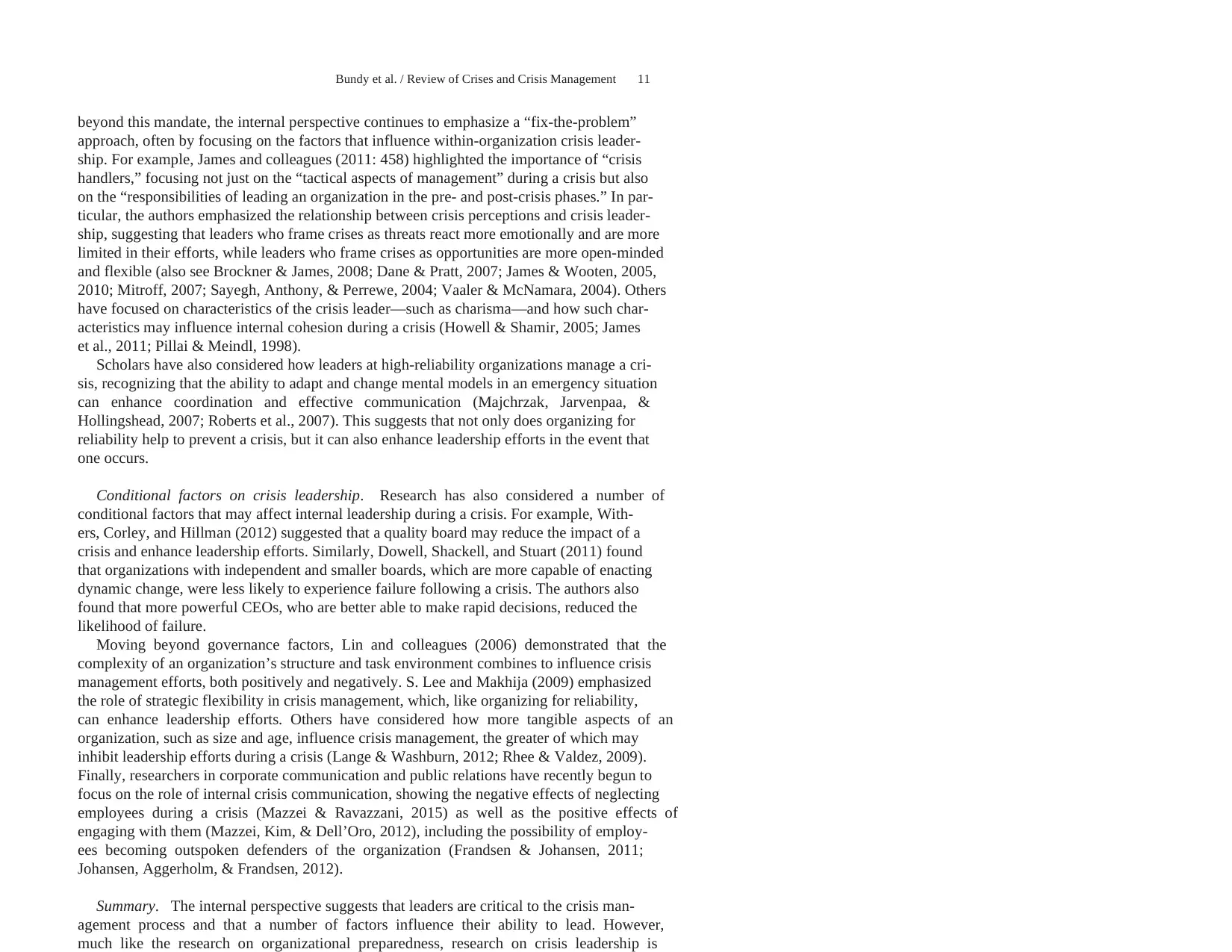
Bundy et al. / Review of Crises and Crisis Management 11
beyond this mandate, the internal perspective continues to emphasize a “fix-the-problem”
approach, often by focusing on the factors that influence within-organization crisis leader-
ship. For example, James and colleagues (2011: 458) highlighted the importance of “crisis
handlers,” focusing not just on the “tactical aspects of management” during a crisis but also
on the “responsibilities of leading an organization in the pre- and post-crisis phases.” In par-
ticular, the authors emphasized the relationship between crisis perceptions and crisis leader-
ship, suggesting that leaders who frame crises as threats react more emotionally and are more
limited in their efforts, while leaders who frame crises as opportunities are more open-minded
and flexible (also see Brockner & James, 2008; Dane & Pratt, 2007; James & Wooten, 2005,
2010; Mitroff, 2007; Sayegh, Anthony, & Perrewe, 2004; Vaaler & McNamara, 2004). Others
have focused on characteristics of the crisis leader—such as charisma—and how such char-
acteristics may influence internal cohesion during a crisis (Howell & Shamir, 2005; James
et al., 2011; Pillai & Meindl, 1998).
Scholars have also considered how leaders at high-reliability organizations manage a cri-
sis, recognizing that the ability to adapt and change mental models in an emergency situation
can enhance coordination and effective communication (Majchrzak, Jarvenpaa, &
Hollingshead, 2007; Roberts et al., 2007). This suggests that not only does organizing for
reliability help to prevent a crisis, but it can also enhance leadership efforts in the event that
one occurs.
Conditional factors on crisis leadership. Research has also considered a number of
conditional factors that may affect internal leadership during a crisis. For example, With-
ers, Corley, and Hillman (2012) suggested that a quality board may reduce the impact of a
crisis and enhance leadership efforts. Similarly, Dowell, Shackell, and Stuart (2011) found
that organizations with independent and smaller boards, which are more capable of enacting
dynamic change, were less likely to experience failure following a crisis. The authors also
found that more powerful CEOs, who are better able to make rapid decisions, reduced the
likelihood of failure.
Moving beyond governance factors, Lin and colleagues (2006) demonstrated that the
complexity of an organization’s structure and task environment combines to influence crisis
management efforts, both positively and negatively. S. Lee and Makhija (2009) emphasized
the role of strategic flexibility in crisis management, which, like organizing for reliability,
can enhance leadership efforts. Others have considered how more tangible aspects of an
organization, such as size and age, influence crisis management, the greater of which may
inhibit leadership efforts during a crisis (Lange & Washburn, 2012; Rhee & Valdez, 2009).
Finally, researchers in corporate communication and public relations have recently begun to
focus on the role of internal crisis communication, showing the negative effects of neglecting
employees during a crisis (Mazzei & Ravazzani, 2015) as well as the positive effects of
engaging with them (Mazzei, Kim, & Dell’Oro, 2012), including the possibility of employ-
ees becoming outspoken defenders of the organization (Frandsen & Johansen, 2011;
Johansen, Aggerholm, & Frandsen, 2012).
Summary. The internal perspective suggests that leaders are critical to the crisis man-
agement process and that a number of factors influence their ability to lead. However,
much like the research on organizational preparedness, research on crisis leadership is
beyond this mandate, the internal perspective continues to emphasize a “fix-the-problem”
approach, often by focusing on the factors that influence within-organization crisis leader-
ship. For example, James and colleagues (2011: 458) highlighted the importance of “crisis
handlers,” focusing not just on the “tactical aspects of management” during a crisis but also
on the “responsibilities of leading an organization in the pre- and post-crisis phases.” In par-
ticular, the authors emphasized the relationship between crisis perceptions and crisis leader-
ship, suggesting that leaders who frame crises as threats react more emotionally and are more
limited in their efforts, while leaders who frame crises as opportunities are more open-minded
and flexible (also see Brockner & James, 2008; Dane & Pratt, 2007; James & Wooten, 2005,
2010; Mitroff, 2007; Sayegh, Anthony, & Perrewe, 2004; Vaaler & McNamara, 2004). Others
have focused on characteristics of the crisis leader—such as charisma—and how such char-
acteristics may influence internal cohesion during a crisis (Howell & Shamir, 2005; James
et al., 2011; Pillai & Meindl, 1998).
Scholars have also considered how leaders at high-reliability organizations manage a cri-
sis, recognizing that the ability to adapt and change mental models in an emergency situation
can enhance coordination and effective communication (Majchrzak, Jarvenpaa, &
Hollingshead, 2007; Roberts et al., 2007). This suggests that not only does organizing for
reliability help to prevent a crisis, but it can also enhance leadership efforts in the event that
one occurs.
Conditional factors on crisis leadership. Research has also considered a number of
conditional factors that may affect internal leadership during a crisis. For example, With-
ers, Corley, and Hillman (2012) suggested that a quality board may reduce the impact of a
crisis and enhance leadership efforts. Similarly, Dowell, Shackell, and Stuart (2011) found
that organizations with independent and smaller boards, which are more capable of enacting
dynamic change, were less likely to experience failure following a crisis. The authors also
found that more powerful CEOs, who are better able to make rapid decisions, reduced the
likelihood of failure.
Moving beyond governance factors, Lin and colleagues (2006) demonstrated that the
complexity of an organization’s structure and task environment combines to influence crisis
management efforts, both positively and negatively. S. Lee and Makhija (2009) emphasized
the role of strategic flexibility in crisis management, which, like organizing for reliability,
can enhance leadership efforts. Others have considered how more tangible aspects of an
organization, such as size and age, influence crisis management, the greater of which may
inhibit leadership efforts during a crisis (Lange & Washburn, 2012; Rhee & Valdez, 2009).
Finally, researchers in corporate communication and public relations have recently begun to
focus on the role of internal crisis communication, showing the negative effects of neglecting
employees during a crisis (Mazzei & Ravazzani, 2015) as well as the positive effects of
engaging with them (Mazzei, Kim, & Dell’Oro, 2012), including the possibility of employ-
ees becoming outspoken defenders of the organization (Frandsen & Johansen, 2011;
Johansen, Aggerholm, & Frandsen, 2012).
Summary. The internal perspective suggests that leaders are critical to the crisis man-
agement process and that a number of factors influence their ability to lead. However,
much like the research on organizational preparedness, research on crisis leadership is
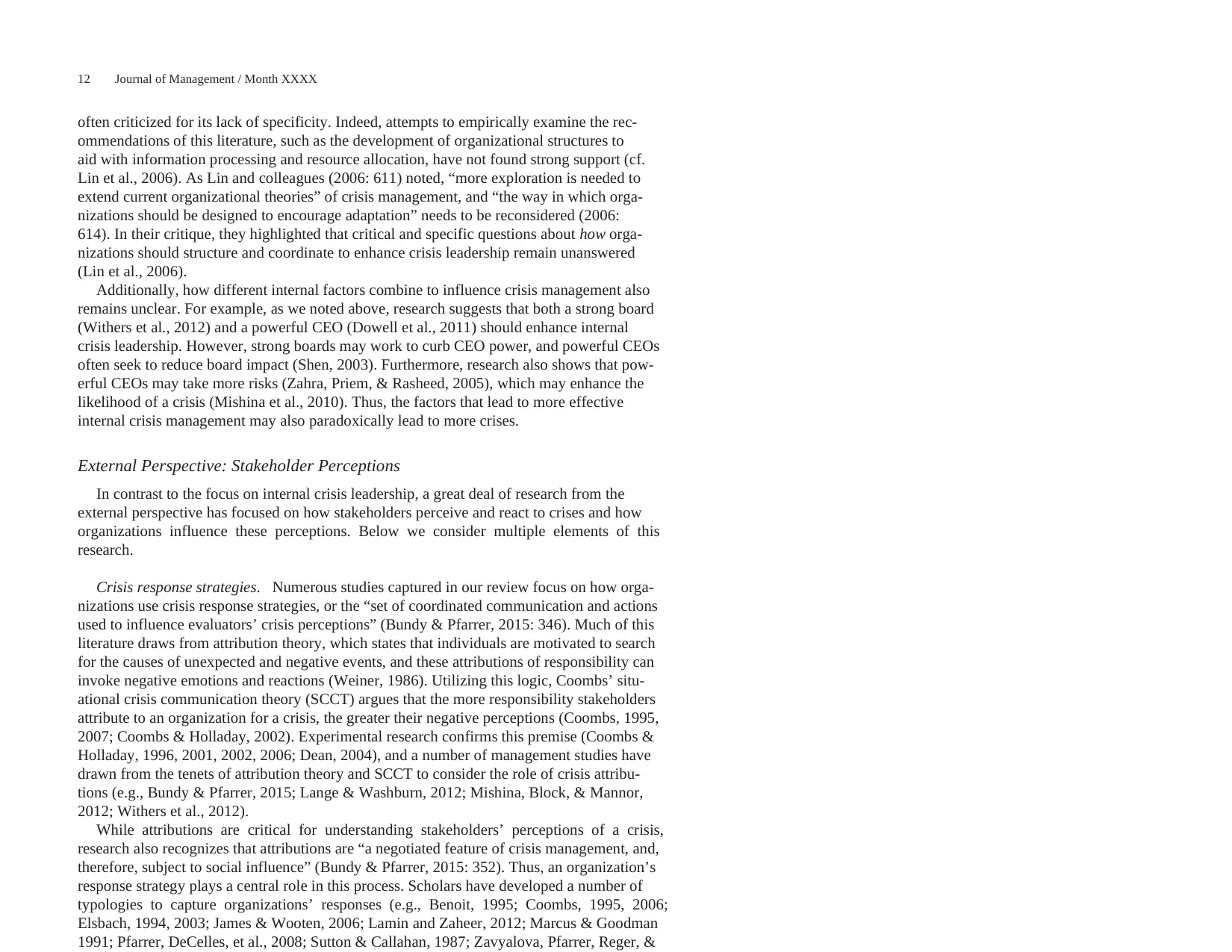
12 Journal of Management / Month XXXX
often criticized for its lack of specificity. Indeed, attempts to empirically examine the rec-
ommendations of this literature, such as the development of organizational structures to
aid with information processing and resource allocation, have not found strong support (cf.
Lin et al., 2006). As Lin and colleagues (2006: 611) noted, “more exploration is needed to
extend current organizational theories” of crisis management, and “the way in which orga-
nizations should be designed to encourage adaptation” needs to be reconsidered (2006:
614). In their critique, they highlighted that critical and specific questions about how orga-
nizations should structure and coordinate to enhance crisis leadership remain unanswered
(Lin et al., 2006).
Additionally, how different internal factors combine to influence crisis management also
remains unclear. For example, as we noted above, research suggests that both a strong board
(Withers et al., 2012) and a powerful CEO (Dowell et al., 2011) should enhance internal
crisis leadership. However, strong boards may work to curb CEO power, and powerful CEOs
often seek to reduce board impact (Shen, 2003). Furthermore, research also shows that pow-
erful CEOs may take more risks (Zahra, Priem, & Rasheed, 2005), which may enhance the
likelihood of a crisis (Mishina et al., 2010). Thus, the factors that lead to more effective
internal crisis management may also paradoxically lead to more crises.
External Perspective: Stakeholder Perceptions
In contrast to the focus on internal crisis leadership, a great deal of research from the
external perspective has focused on how stakeholders perceive and react to crises and how
organizations influence these perceptions. Below we consider multiple elements of this
research.
Crisis response strategies. Numerous studies captured in our review focus on how orga-
nizations use crisis response strategies, or the “set of coordinated communication and actions
used to influence evaluators’ crisis perceptions” (Bundy & Pfarrer, 2015: 346). Much of this
literature draws from attribution theory, which states that individuals are motivated to search
for the causes of unexpected and negative events, and these attributions of responsibility can
invoke negative emotions and reactions (Weiner, 1986). Utilizing this logic, Coombs’ situ-
ational crisis communication theory (SCCT) argues that the more responsibility stakeholders
attribute to an organization for a crisis, the greater their negative perceptions (Coombs, 1995,
2007; Coombs & Holladay, 2002). Experimental research confirms this premise (Coombs &
Holladay, 1996, 2001, 2002, 2006; Dean, 2004), and a number of management studies have
drawn from the tenets of attribution theory and SCCT to consider the role of crisis attribu-
tions (e.g., Bundy & Pfarrer, 2015; Lange & Washburn, 2012; Mishina, Block, & Mannor,
2012; Withers et al., 2012).
While attributions are critical for understanding stakeholders’ perceptions of a crisis,
research also recognizes that attributions are “a negotiated feature of crisis management, and,
therefore, subject to social influence” (Bundy & Pfarrer, 2015: 352). Thus, an organization’s
response strategy plays a central role in this process. Scholars have developed a number of
typologies to capture organizations’ responses (e.g., Benoit, 1995; Coombs, 1995, 2006;
Elsbach, 1994, 2003; James & Wooten, 2006; Lamin and Zaheer, 2012; Marcus & Goodman
1991; Pfarrer, DeCelles, et al., 2008; Sutton & Callahan, 1987; Zavyalova, Pfarrer, Reger, &
often criticized for its lack of specificity. Indeed, attempts to empirically examine the rec-
ommendations of this literature, such as the development of organizational structures to
aid with information processing and resource allocation, have not found strong support (cf.
Lin et al., 2006). As Lin and colleagues (2006: 611) noted, “more exploration is needed to
extend current organizational theories” of crisis management, and “the way in which orga-
nizations should be designed to encourage adaptation” needs to be reconsidered (2006:
614). In their critique, they highlighted that critical and specific questions about how orga-
nizations should structure and coordinate to enhance crisis leadership remain unanswered
(Lin et al., 2006).
Additionally, how different internal factors combine to influence crisis management also
remains unclear. For example, as we noted above, research suggests that both a strong board
(Withers et al., 2012) and a powerful CEO (Dowell et al., 2011) should enhance internal
crisis leadership. However, strong boards may work to curb CEO power, and powerful CEOs
often seek to reduce board impact (Shen, 2003). Furthermore, research also shows that pow-
erful CEOs may take more risks (Zahra, Priem, & Rasheed, 2005), which may enhance the
likelihood of a crisis (Mishina et al., 2010). Thus, the factors that lead to more effective
internal crisis management may also paradoxically lead to more crises.
External Perspective: Stakeholder Perceptions
In contrast to the focus on internal crisis leadership, a great deal of research from the
external perspective has focused on how stakeholders perceive and react to crises and how
organizations influence these perceptions. Below we consider multiple elements of this
research.
Crisis response strategies. Numerous studies captured in our review focus on how orga-
nizations use crisis response strategies, or the “set of coordinated communication and actions
used to influence evaluators’ crisis perceptions” (Bundy & Pfarrer, 2015: 346). Much of this
literature draws from attribution theory, which states that individuals are motivated to search
for the causes of unexpected and negative events, and these attributions of responsibility can
invoke negative emotions and reactions (Weiner, 1986). Utilizing this logic, Coombs’ situ-
ational crisis communication theory (SCCT) argues that the more responsibility stakeholders
attribute to an organization for a crisis, the greater their negative perceptions (Coombs, 1995,
2007; Coombs & Holladay, 2002). Experimental research confirms this premise (Coombs &
Holladay, 1996, 2001, 2002, 2006; Dean, 2004), and a number of management studies have
drawn from the tenets of attribution theory and SCCT to consider the role of crisis attribu-
tions (e.g., Bundy & Pfarrer, 2015; Lange & Washburn, 2012; Mishina, Block, & Mannor,
2012; Withers et al., 2012).
While attributions are critical for understanding stakeholders’ perceptions of a crisis,
research also recognizes that attributions are “a negotiated feature of crisis management, and,
therefore, subject to social influence” (Bundy & Pfarrer, 2015: 352). Thus, an organization’s
response strategy plays a central role in this process. Scholars have developed a number of
typologies to capture organizations’ responses (e.g., Benoit, 1995; Coombs, 1995, 2006;
Elsbach, 1994, 2003; James & Wooten, 2006; Lamin and Zaheer, 2012; Marcus & Goodman
1991; Pfarrer, DeCelles, et al., 2008; Sutton & Callahan, 1987; Zavyalova, Pfarrer, Reger, &
⊘ This is a preview!⊘
Do you want full access?
Subscribe today to unlock all pages.

Trusted by 1+ million students worldwide
1 out of 51
Your All-in-One AI-Powered Toolkit for Academic Success.
+13062052269
info@desklib.com
Available 24*7 on WhatsApp / Email
![[object Object]](/_next/static/media/star-bottom.7253800d.svg)
Unlock your academic potential
Copyright © 2020–2025 A2Z Services. All Rights Reserved. Developed and managed by ZUCOL.